Motorola Mobility T56CD1 Portable PCS GSM Transceiver User Manual Exhibit 8 Preliminary Users Manual
Motorola Mobility LLC Portable PCS GSM Transceiver Exhibit 8 Preliminary Users Manual
Exhibit 8 Preliminary Users Manual

APPLICANT: MOTOROLA, INC. FCC ID: IHDT56CD1
EXHIBIT 8
INSTRUCTION MANUAL
A preliminary draft copy of the Users Manual follows:
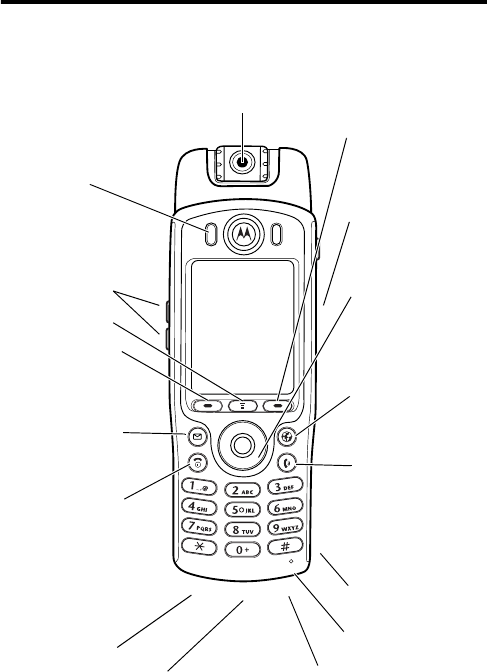
1
PRELIMINARY
Welcome
This user guide introduces you to the many features in your phone.
Power/End Key
Press & hold to
power phone on
& off.
Press & release to
end phone calls,
exit menu system.
Send Key
Make and
answer calls,
view recent /
dialed calls list.
Browser Key
Opens Web
page browser.
Left Soft Key
Perform functions
identified by left
display prompt.
Camera Attachment
(not available on all phones)
Earpiece
Microphone
SD Card Slot
Insert SD Card
RF Jack
For handsfree kits
Navigation Key
Scroll through
menus and lists,
set feature
values.
Messages Key
Opens message
menu.
Right Soft Key
Perform functions
identified by right
display prompt.
Menu Key
Volume Keys
Voice Key
Create and use
voice recordings.
Serial/USB Connector Port
Attach accessories.
Power Connector Port
Insert charger.
2
PRELIMINARY
Personal Communications Sector
600 North U.S. Highway 45
Libertyville, Illinois 60048
1-800-331-6456 (United States)
1-888-390-6456 (TTY/TDD United States)
1-800-461-4575 (Canada)
www.motorola.com
(United States)
www.motorola.ca
(Canada)
MOTOROLA, the Stylized M Logo and all other trademarks indicated as
such herein are trademarks of Motorola, Inc. ® Reg. U.S. Pat. & Tm. Off.
TrueSync, Sidekick, Starfish and the Stylized Starfish Logo are registered
trademarks of Starfish Software, Inc., a wholly owned independent
subsidiary of Motorola, Inc. All other product or service names are the
property of their respective owners.
© 2002 Motorola, Inc. All rights reserved. Printed in the U.S.A.
Software Copyright Notice
The Motorola products described in this manual may include copyrighted
Motorola and third party software stored in semiconductor memories or
other media. Laws in the United States and other countries preserve for
Motorola and third party software providers certain exclusive rights for
copyrighted software, such as the exclusive rights to distribute or
reproduce the copyrighted software. Accordingly, any copyrighted
software contained in the Motorola products may not be modified,
reverse-engineered, distributed, or reproduced in any manner to the
extent allowed by law. Furthermore, the purchase of the Motorola
products shall not be deemed to grant either directly or by implication,
estoppel, or otherwise, any license under the copyrights, patents, or
patent applications of Motorola or any third party software provider,
except for the normal, non-exclusive, royalty-free license to use that
arises by operation of law in the sale of a product.
Java and all other Java-based marks are trademarks or registered
trademarks of Sun Microsystems, Inc. in the U.S. and other countries.
Manual number:
Cover number: 6809452A36

3
PRELIMINARY
Menu Map
Main Menu
v
Media Center
q
Audio
P
i
Pictures
l
Video
-
Games & Apps
d
Ring Styles
:
Shortcuts
m
Office Tools
g
Datebook
O
Voice Notes
a
Calculator
/
Settings
(see next page)
B
Web Access
G
Browser
D
Web Shortcuts
C
Stored Pages
b
History
o
Goto URL
p
Browser Setup
j
Services
7
SIM Applications
Z
Fixed Dial
9
Service Dial
f
Quick Dial
>
Extras
F
Web Sessions
r
Phonebook
U
Messages
z
Recent Calls
n
Quick Menu
Note:
This is the
standard phone menu
layout. You or your
service provider may
have changed the menu
layout or changed some
feature names. Not all
features may be
available for all users.
Shortcuts
Change display zoom:
Press
M
, then press
and hold
M
Lock/unlock keypad:
Press
M
*
Display my phone
number:
Press
M#
Go to dialed calls list:
Press
N
Exit menu system:
Press
O
See page 64 for more
about Shortcuts
4
PRELIMINARY
Settings
I
Personalize
Main Menu
Home Keys
Power Up
Greeting
Banner
Banner Graphic
Wallpaper
Screen Saver
Quick Dial
M
Call Forward
Voice Calls
Data Calls
Cancel All
Forward Status
K
Connection
IrDA Link
Active Call
Bluetooth Link
Sync
Incoming Call
y
Phone Status
My Tel. Number
Active Line
Battery Meter
User Account
Storage Devices
Other Information
k
Security
Phone Lock
Lock Keypad
Lock Application
Fixed Dialing
Call Barring
SIM PIN
Universal PIN
WIM PINs
New Passwords
\
Other Settings
0
Initial Setup
• Time and Date
•1-Touch Dial
• Display Timeout
• Backlight
•Zoom
•Scroll
• Animation
• Language
• Battery Save
•DTMF
•Master Reset
• Master Clear
1
In-Call Setup
•In-Call Timer
• Call Guard
• Call Cost Setup
•My Caller ID
• Call Waiting
• Answer Options
E
Network
• New Network
• Network Setup
• Available Networks
• My Network List
• Service Tone
• Call Drop Tone
L
Car Settings
• Auto Answer
• Auto Handsfree
• Power Off Delay
• Charger Time
J
Headset
• Auto Answer
• Ringer Options
h
Java Tools

5
PRELIMINARY
Contents
Menu Map
. . . . . . . . . . . . . . . . . . . . . . . . . . . . . . . . . . . . 3
Safety and General Information
. . . . . . . . . . . . . . . . . . . 8
Getting Started
. . . . . . . . . . . . . . . . . . . . . . . . . . . . . . . 16
What’s in the Box? . . . . . . . . . . . . . . . . . . . . . . . . . . . 16
About This Guide . . . . . . . . . . . . . . . . . . . . . . . . . . . . 16
Reinstalling the Camera . . . . . . . . . . . . . . . . . . . . . . . 17
Installing the SIM Card . . . . . . . . . . . . . . . . . . . . . . . . 18
Installing the Battery . . . . . . . . . . . . . . . . . . . . . . . . . .19
Charging the Battery . . . . . . . . . . . . . . . . . . . . . . . . . 20
Battery Use . . . . . . . . . . . . . . . . . . . . . . . . . . . . . . . . 21
Turning Your Phone On . . . . . . . . . . . . . . . . . . . . . . . 23
Adjusting Volume . . . . . . . . . . . . . . . . . . . . . . . . . . . . 24
Making and Answering Calls . . . . . . . . . . . . . . . . . . . 25
Using Your Phone
. . . . . . . . . . . . . . . . . . . . . . . . . . . . . 27
Display Symbols . . . . . . . . . . . . . . . . . . . . . . . . . . . . . 27
Using the 4-Way Navigation Key . . . . . . . . . . . . . . . . 29
Using the Message and Browser Keys . . . . . . . . . . . . 30
Using the Menu . . . . . . . . . . . . . . . . . . . . . . . . . . . . . 30
Setting Up Your Phone . . . . . . . . . . . . . . . . . . . . . . . . 31
Entering and Editing Text . . . . . . . . . . . . . . . . . . . . . . 33
Calling Features
. . . . . . . . . . . . . . . . . . . . . . . . . . . . . . 37
Redialing a Number . . . . . . . . . . . . . . . . . . . . . . . . . . 37
Using Caller ID . . . . . . . . . . . . . . . . . . . . . . . . . . . . . . 37
Dialing an Emergency Number . . . . . . . . . . . . . . . . . 38
Inserting Special Characters into Dialing Sequences 39
Viewing Recent Calls . . . . . . . . . . . . . . . . . . . . . . . . . 40
Using Voicemail . . . . . . . . . . . . . . . . . . . . . . . . . . . . . 40
Voice Dialing . . . . . . . . . . . . . . . . . . . . . . . . . . . . . . . . 41

6
PRELIMINARY
Speed Dialing . . . . . . . . . . . . . . . . . . . . . . . . . . . . . . 42
1-Touch Dialing . . . . . . . . . . . . . . . . . . . . . . . . . . . . . 42
Using Call Waiting . . . . . . . . . . . . . . . . . . . . . . . . . . . 42
Forwarding a Call . . . . . . . . . . . . . . . . . . . . . . . . . . . . 43
Transferring a Call . . . . . . . . . . . . . . . . . . . . . . . . . . . 44
Barring a Call . . . . . . . . . . . . . . . . . . . . . . . . . . . . . . . 44
Putting a Call on Hold . . . . . . . . . . . . . . . . . . . . . . . . 45
Making a Conference Call . . . . . . . . . . . . . . . . . . . . . 45
Using Other Features During a Call . . . . . . . . . . . . . 46
Messages and Email
. . . . . . . . . . . . . . . . . . . . . . . . . . 48
Creating and Sending Messages . . . . . . . . . . . . . . . 48
Viewing Message Status . . . . . . . . . . . . . . . . . . . . . . 51
Receiving and Reading Messages . . . . . . . . . . . . . . 52
Phonebook
. . . . . . . . . . . . . . . . . . . . . . . . . . . . . . . . . . 53
Items in a Phonebook Entry . . . . . . . . . . . . . . . . . . . 54
Storing a Phonebook Entry . . . . . . . . . . . . . . . . . . . . 54
Recording a Voice Name For a Phonebook Entry . . . 56
Dialing a Phonebook Entry . . . . . . . . . . . . . . . . . . . . 57
Editing a Phonebook Entry . . . . . . . . . . . . . . . . . . . . 57
Using Phonebook Categories . . . . . . . . . . . . . . . . . . 59
Customizing Your Phone Settings
. . . . . . . . . . . . . . . 63
Customizing Menus and Display . . . . . . . . . . . . . . . . 63
Using Shortcuts . . . . . . . . . . . . . . . . . . . . . . . . . . . . . 64
Setting Your Display Timeout . . . . . . . . . . . . . . . . . . . 65
Getting More Out of Your Phone
. . . . . . . . . . . . . . . . . 66
Using Hands Free Features . . . . . . . . . . . . . . . . . . . . 66
Dialing Options . . . . . . . . . . . . . . . . . . . . . . . . . . . . . 66
Monitoring Phone Use . . . . . . . . . . . . . . . . . . . . . . . . 67
Network Features . . . . . . . . . . . . . . . . . . . . . . . . . . . 68
Connecting Your Phone to an External Device . . . . . 69
Data Calls . . . . . . . . . . . . . . . . . . . . . . . . . . . . . . . . . 72

7
PRELIMINARY
Using Sync . . . . . . . . . . . . . . . . . . . . . . . . . . . . . . . . . 73
Using an SD or MMC Card . . . . . . . . . . . . . . . . . . . . . 75
Security
. . . . . . . . . . . . . . . . . . . . . . . . . . . . . . . . . . . . . 76
Line Security . . . . . . . . . . . . . . . . . . . . . . . . . . . . . . . 76
Locking and Unlocking Your Phone . . . . . . . . . . . . . . 76
Changing Your Unlock Code . . . . . . . . . . . . . . . . . . . 76
If You Forget Your Unlock Code . . . . . . . . . . . . . . . . . 78
Locking and Unlocking the Keypad . . . . . . . . . . . . . . 78
Protecting the SIM Card . . . . . . . . . . . . . . . . . . . . . . . 79
Personal Organizer Features
. . . . . . . . . . . . . . . . . . . . 80
Datebook . . . . . . . . . . . . . . . . . . . . . . . . . . . . . . . . . . 80
Alarm Reminders . . . . . . . . . . . . . . . . . . . . . . . . . . . . 82
Voice Notes . . . . . . . . . . . . . . . . . . . . . . . . . . . . . . . . 82
Calculator and Currency Converter . . . . . . . . . . . . . . 86
News and Entertainment
. . . . . . . . . . . . . . . . . . . . . . . 87
Mobile Internet . . . . . . . . . . . . . . . . . . . . . . . . . . . . . . 87
Java Applications . . . . . . . . . . . . . . . . . . . . . . . . . . . . 89
Camera and Picture Viewer . . . . . . . . . . . . . . . . . . . . 89
Video Recorder and Viewer . . . . . . . . . . . . . . . . . . . . 92
Games . . . . . . . . . . . . . . . . . . . . . . . . . . . . . . . . . . . . 93
SIM Applications . . . . . . . . . . . . . . . . . . . . . . . . . . . . . 94
Specific Absorption Rate Data
. . . . . . . . . . . . . . . . . . 95
Warranty
. . . . . . . . . . . . . . . . . . . . . . . . . . . . . . . . . . . . 97
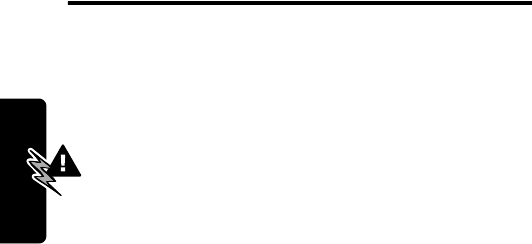
8
PRELIMINARY
Safety and General Information
Safety and General
Information
IMPORTANT INFORMATION ON SAFE AND EFFICIENT
OPERATION. READ THIS INFORMATION BEFORE
USING YOUR PHONE.
The information provided in this document supersedes
the general safety information contained in user guides
published prior to July 2000. For information regarding
radio use in a hazardous atmosphere please refer to
the Factory Mutual (FM) Approval Manual Supplement or
Instruction Card, which is included with radio models that
offer this capability.
This device complies with Part 15 of the FCC Rules.
Operation is subject to the following two conditions: (1)
this device may not cause harmful interference, and (2)
this device must accept any interference received,
including interference that may cause undesired operation.
RF Operational Characteristics
Your phone contains a transmitter and a receiver. When it
is ON, it receives and transmits radio frequency (RF)
energy. The phone operates in the frequency range of 880
to 960 MHz (GSM), 1710 to 1880 MHz (DCS), 1850 to
1990 MHz (PCS), 1920 to 2170 MHz (WCDMA), and 2402
to 2485 MHz (Bluetooth).
When you communicate with your phone, the system
handling your call controls the power level at which your

9
PRELIMINARY
Safety and General Information
phone transmits. The output power level typically may vary
over a range from 0.0 watts to 2.0 watts.
Exposure To Radio Frequency Energy
Your Motorola phone is designed to comply with the
following national and international standards and
guidelines regarding exposure of human beings to radio
frequency electromagnetic energy:
•
United States Federal Communications
Commission, Code of Regulations; 47 CFR part 2
sub-part J
•
American National Standards Institute (ANSI) /
Institute of Electrical and Electronic Engineers (IEEE)
C95. 1-1992
•
Institute of Electrical and Electronic Engineers (IEEE)
C95.1-1999 Edition
•
National Council on Radiation Protection and
Measurements (NCRP) of the United States, Report
86, 1986
•
International Commission on Non-Ionizing Radiation
Protection (ICNIRP) 1998
•
Ministry of Health (Canada) Safety Code 6. Limits of
Human Exposure to Radiofrequency Electromagnetic
Fields in the Frequency Range from 3 kHz to 300
GHz, 1999
•
Australian Communications Authority
Radiocommunications (Electromagnetic
Radiation-Human Exposure) Standard 1999

10
PRELIMINARY
Safety and General Information
To assure optimal phone performance and make sure
human exposure to radio frequency electromagnetic
energy is within the guidelines set forth in the above
standards, always adhere to the following procedures:
Portable Phone Operation and EME
Exposure
Antenna Care
Use only the supplied or an approved replacement
antenna.
Unauthorized antennas, modifications, or
attachments could damage the phone and may violate
FCC regulations.
Do NOT hold the antenna when the phone is “IN USE”.
Holding the antenna affects call quality and may cause the
phone to operate at a higher power level than needed.
Phone Operation
When placing or receiving a phone call, hold your phone
as you would a wireline telephone.
Speak directly into
the microphone.
Body-Worn Operation
To maintain compliance with FCC/Health Canada RF
exposure guidelines, if you wear a phone on your body
when transmitting, always place the phone in a
Motorola-supplied or approved clip, holder, holster, case,
or body harness for this product. Use of
non-Motorola-approved accessories may exceed FCC/
Health Canada RF exposure guidelines. If you do not use
one of the Motorola-supplied or approved body-worn
accessories, and are not using the phone held in the

11
PRELIMINARY
Safety and General Information
normal use position,
ensure the phone and its antenna
are at least one inch (2.5 cm) from your body when
transmitting.
Data Operation
When using any data feature of the phone, with or without
an accessory cable,
position the phone and its antenna
at least one inch (2.5 centimeters) from the body.
Approved Accessories
For a list of approved Motorola accessories, visit our
website at
www.mot.com
.
Electromagnetic Interference/Compatibility
Note:
Nearly every electronic device is susceptible to
electromagnetic interference (EMI) if inadequately
shielded, designed, or otherwise configured for
electromagnetic compatibility.
Facilities
To avoid electromagnetic interference and/or compatibility
conflicts, turn off your phone in any facility where posted
notices instruct you to do so. Hospitals or health care
facilities may be using equipment that is sensitive to
external RF energy.
Aircraft
When instructed to do so, turn off your phone when on
board an aircraft. Any use of a phone must be in
accordance with applicable regulations per airline crew
instructions.

12
PRELIMINARY
Safety and General Information
Medical Devices
Pacemakers
The Advanced Medical Technology Association
recommends that a minimum separation of 6 inches
(15 centimeters) be maintained between a handheld
wireless phone and a pacemaker. These
recommendations are consistent with the independent
research by, and recommendations of, the United States
Food and Drug Administration.
Persons with pacemakers should:
•
ALWAYS keep the phone more than six inches
(15 centimeters) from your pacemaker when the
phone is turned ON.
•
NOT carry the phone in the breast pocket.
•
use the ear opposite the pacemaker to minimize the
potential for interference.
•
turn the phone OFF immediately if you have any
reason to suspect that interference is taking place.
Hearing Aids
Some digital wireless phones may interfere with some
hearing aids. In the event of such interference, you may
want to consult your hearing aid manufacturer to discuss
alternatives.
Other Medical Devices
If you use any other personal medical device, consult the
manufacturer of your device to determine if it is adequately
shielded from RF energy. Your physician may be able to
assist you in obtaining this information.

13
PRELIMINARY
Safety and General Information
Safety and General Use While Driving
Check the laws and regulations on the use of phones in
the area where you drive. Always obey them.
When using your phone while driving, please:
•
Give full attention to driving and to the road.
•
Use hands-free operation, if available.
•
Pull off the road and park before making or
answering a call if driving conditions so require.
Operational Warnings
For Vehicles With an Air Bag
Do not place a portable phone in the area over an air bag
or in the air bag deployment area. Air bags inflate with
great force. If a portable phone is placed in the air bag
deployment area and the air bag inflates, the phone may
be propelled with great force and cause serious injury to
occupants of the vehicle.
Potentially Explosive Atmospheres
Turn off your phone prior to entering any area with a
potentially explosive atmosphere, unless it is a phone type
especially qualified for use in such areas as “Intrinsically
Safe.” Do not remove, install, or charge batteries in such
areas. Sparks in a potentially explosive atmosphere can
cause an explosion or fire resulting in bodily injury or even
death.
Note:
The areas with potentially explosive atmospheres
referred to above include fueling areas such as below
decks on boats, fuel or chemical transfer or storage

14
PRELIMINARY
Safety and General Information
facilities, areas where the air contains chemicals or
particles, such as grain, dust, or metal powders, and any
other area where you would normally be advised to turn off
your vehicle engine. Areas with potentially explosive
atmospheres are often but not always posted.
Blasting Caps and Areas
To avoid possible interference with blasting operations,
turn off your phone when you are near electrical
blasting caps, in a blasting area, or in areas posted:
“Turn off two-way radio.” Obey all signs and
instructions.
Operational Cautions
Antennas
Do not use any portable phone that has a damaged
antenna.
If a damaged antenna comes into contact with
your skin, a minor burn can result.
Batteries
All batteries can cause property damage and/or bodily
injury such as burns if a conductive material such as
jewelry, keys, or beaded chains touches exposed
terminals. The conductive material may complete an
electrical circuit (short circuit) and become quite hot.
Exercise care in handling any charged battery, particularly
when placing it inside a pocket, purse, or other container
with metal objects.
ITC01-101
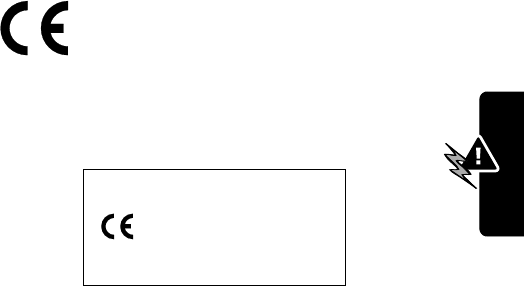
15
PRELIMINARY
Safety and General Information
European Union Directives
Conformance Statement
Hereby, Motorola declares that this product is
in compliance with
•
The essential requirements and other
relevant provisions of Directive 1999/5/EC
•
All other relevant EU Directives
The above gives an example of a typical Product Approval
Number.
You can view your product’s Declaration of Conformity
(DoC) to Directive 1999/5/EC (to R&TTE Directive) at
www.motorola.com/rtte. To find your DoC, enter the
product Approval Number from your product’s label in the
“Search” bar on the web site.
ITC01-072
IMEI: 350034/40/394721/9
0168
Type: MC2-41H14
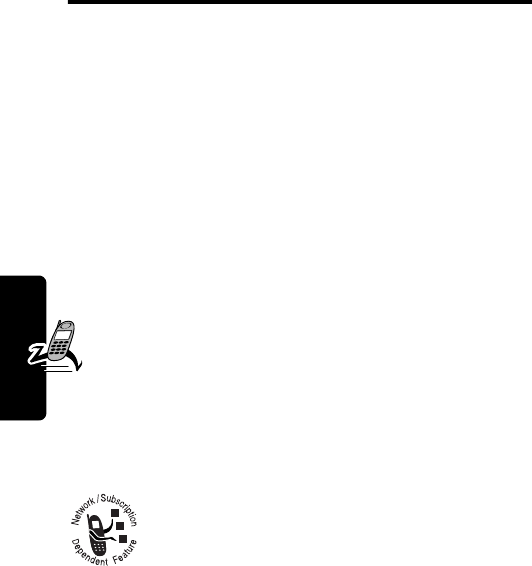
16
PRELIMINARY
Getting Started
Getting Started
What’s in the Box?
Your digital wireless phone has a battery and typically
comes equipped with a charger. Other accessory options
can customize your phone for maximum performance and
portability.
To purchase Motorola Original™ accessories, please
contact the Motorola Customer Call Center at
1-800-331-6456 in the United States or 1-800-461-4575 in
Canada.
For more information, you can also visit:
www.motorola.com
(United States)
www.motorola.ca
(Canada)
About This Guide
Optional Features
Features marked with this label are optional
network, SIM card, and/or subscription-
dependent features. These features may not be
offered by all service providers in all
geographical areas. Contact your service provider for
information about availability.

17
PRELIMINARY
Getting Started
Optional Accessories
Features marked with this label require the use of
an optional Motorola Original™ accessory.
Reinstalling the Camera
Note:
The camera attachment is not available on all
phones.
You can attach or remove a camera for your phone. For
more about camera features, see “Camera and Picture
Viewer” on page 89.
Do This
1
If necessary, push
down the battery
door release latch
and lift the door off
of the phone.
2
Replace the battery
door with the
camera accessory,
inserting the
phone’s antenna
into its hole.
antenna
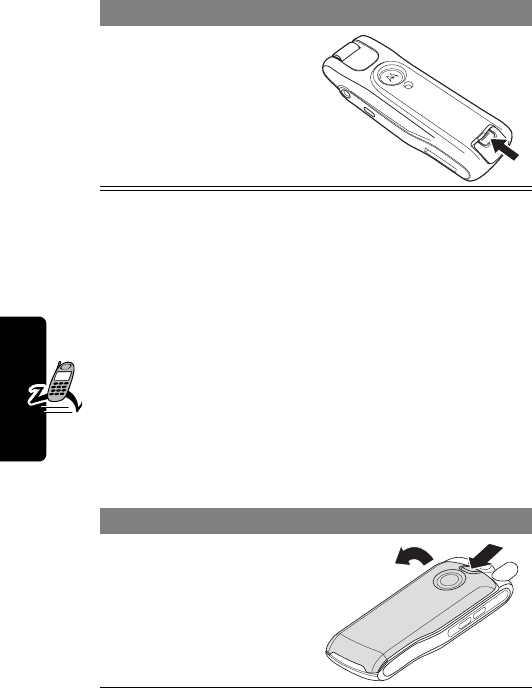
18
PRELIMINARY
Getting Started
Installing the SIM Card
Your SIM (Subscriber Identity Module) card contains your
phone number, service details, and phonebook/message
memory. Your phone can use GSM SIM cards, but not all
features will be available.
Caution:
Do not bend or scratch your SIM card. Avoid
exposing your SIM card to static electricity, water, or
dirt.
If a camera is installed, you need to remove it to access
your SIM card. See “Reinstalling the Camera” on page 17.
3
Slide the camera
latch closed to
secure the camera
in place.
Do This
1
If necessary, push
down the battery
door release latch
and lift the door off
of the phone.
Do This
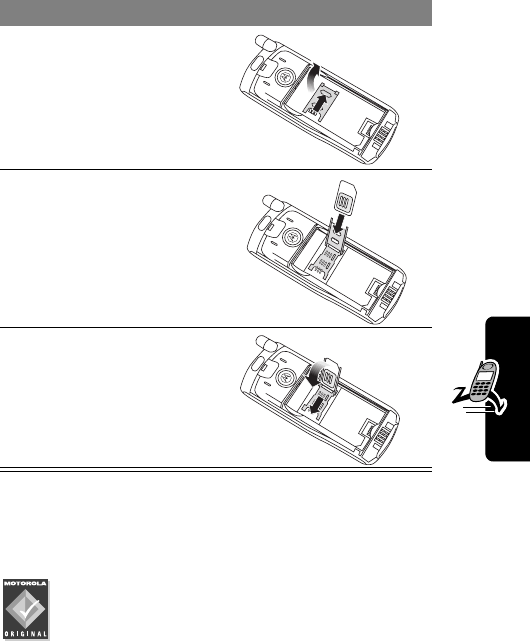
19
PRELIMINARY
Getting Started
Installing the Battery
You must install and charge the battery to use your phone.
Caution:
Your phone is designed to be used only
with Motorola Original batteries and accessories.
We recommend that you store batteries in their
protective cases when not in use.
2
Slide the SIM card
door down and lift
open.
3
Insert the SIM card
into the SIM card
tray with the notch
in the lower left
corner and the gold
plate facing down.
4
Close the SIM card
door and slide it up
to lock the SIM
card in place.
Do This
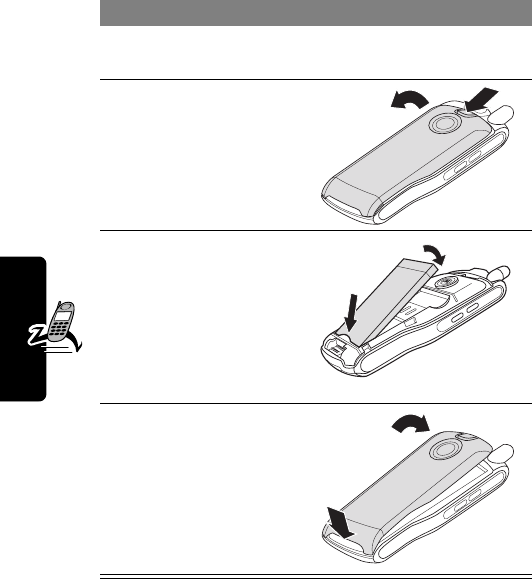
20
PRELIMINARY
Getting Started
If your camera is installed, you need to remove it to access
your battery. See “Reinstalling the Camera” on page 17.
Charging the Battery
New batteries are shipped partially charged. Before you
can use your phone, you need to install and charge the
Do This
1
Remove the battery from its protective clear
plastic case.
2
If necessary, push
down the battery
door release latch
and lift the door off
of the phone.
3
Insert the battery,
printed arrow first,
under the tab
at
the top of the
battery
compartment and
push down.
4
Insert the ridge at
the bottom of the
battery door into
the base of the
phone, then push
the door down and
snap it into place.
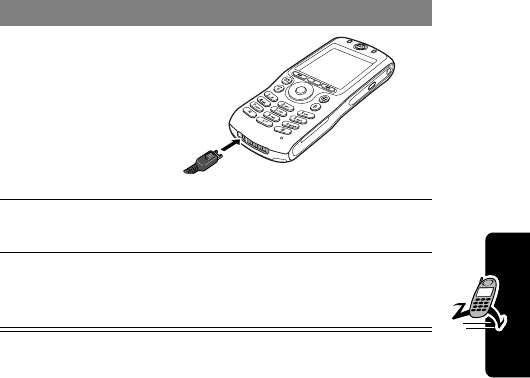
21
PRELIMINARY
Getting Started
battery, as indicated by the following instructions. Some
batteries perform best after several full charge/discharge
cycles.
Note:
When you charge the battery, the battery level
indicator in the upper right corner of the display shows how
much of the charging process is complete.
Battery Use
Battery performance depends on many factors, including
your wireless carrier’s network configuration; signal
strength; the temperature at which you operate your
phone; the features and/or settings you select and use;
and your voice, data, and other application usage patterns.
Do This
1
Plug the
travel
charger into
your phone
with the
release tab
facing up.
2
Plug the other end of the travel charger into the
appropriate electrical outlet.
3
When your phone indicates that the battery is
fully charged (
Charge Complete
), press the release
tab and remove the travel charger.

22
PRELIMINARY
Getting Started
Battery Care
Caution:
To prevent injuries or burns, do not allow metal
objects to contact or short-circuit the battery terminals.
To maximize your battery’s performance:
•
Always use Motorola Original™ batteries and battery
chargers. The phone warranty does not cover
damage caused from using non-Motorola batteries
and/or battery chargers.
•
New batteries or batteries that have been stored for
long periods of time may require a longer charge time.
•
Maintain the battery at or near room temperature
when charging.
•
Do not expose batteries to temperatures below -
10°C (14°F) or above 45°C (113°F). Always take
your phone with you when you leave your vehicle.
•
When you do not intend to use a battery for a while,
store it uncharged in a cool, dark, dry place, such as a
refrigerator.
•
Over extended periods of time, batteries gradually
wear down and require longer charging times. This is
normal. If you charge your battery regularly and notice
a decrease in talk time or an increase in charging
time, then it is probably time to purchase a new
battery.
The rechargeable batteries that power this
product must be disposed of properly and may
need to be recycled. Refer to your battery’s label
for battery type. Contact your local recycling center for
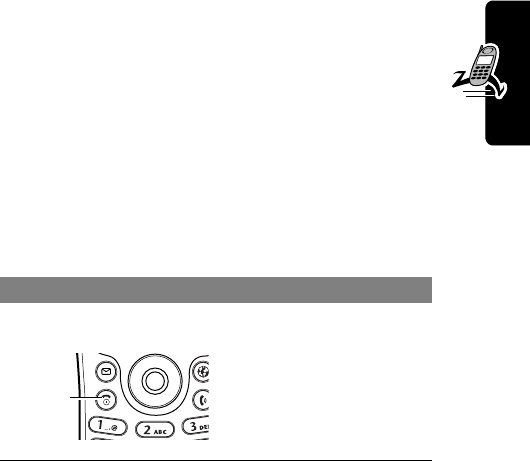
23
PRELIMINARY
Getting Started
proper disposal methods. Never dispose of batteries in a
fire because they may explode.
Extending Battery Life
• Turn off your display backlight
The backlight uses power. To turn it off, see page 32.
• Turn off the screen saver
Using an animated screen saver reduces your
phone’s talk and standby time. To turn it off, see
page 63.
• Use the display timeout
You can tell your phone display to turn off when you
are not using it. See page 65.
• Avoid keypad-intense functions
Activities that require intensive keystroke use
(such as playing a game or using messaging)
reduce your phone’s talk and standby time.
• Avoid the Vibrate ring setting
Your phone’s
Vibrate
ring setting uses more power
than a standard ring sound or the
Silent
setting.
Turning Your Phone On
Do This To
1
Press and hold the
power key
turn on your phone
Power
key
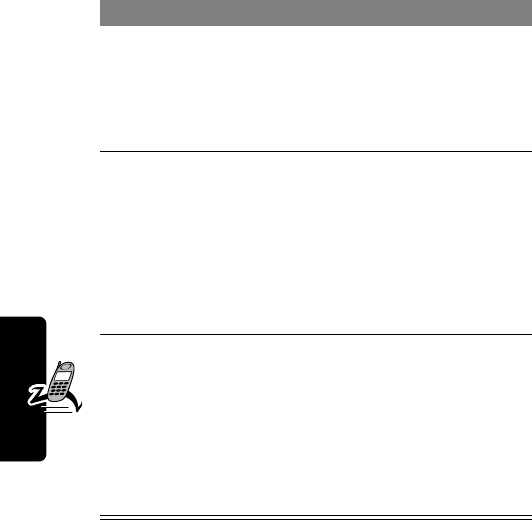
24
PRELIMINARY
Getting Started
Adjusting Volume
Press the upper and lower volume keys to:
•
increase and decrease earpiece or speakerphone
volume during a call
•
increase and decrease the ringer volume setting when
the idle display is visible
•
turn off an incoming call alert
2
If necessary, press
S
to scroll to the
User Account you
want, then press
SELECT
(
+
).
select the user account
you want from the list of
accounts (stored on the
SIM card)
3
If necessary, enter
your SIM card PIN
code and press
OK
(
+
)
unlock your SIM card
Caution:
If you enter an
incorrect PIN code three
times in a row, your SIM
card is disabled and your
phone displays
SIM Blocked
. See page 79.
4
If necessary, enter
your four-digit
unlock code and
press
OK
(
+
)
unlock your phone
The unlock code is
originally set to 1234.
Your service provider
may change this number
before you receive your
phone.
Do This To
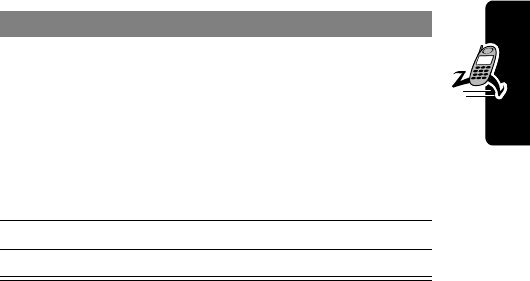
25
PRELIMINARY
Getting Started
Making and Answering Calls
This section summarizes the most basic calling features.
For more features, see “Calling Features” on page 37.
Making a Call
To call a number, your phone must:
•
be turned on with the phone and keypad unlocked
•
have a SIM card inserted and unlocked
•
have a network connection with adequate signal
strength
Note:
You can make an emergency call even when the
phone is locked, or when a SIM card is not inserted. See
“Dialing an Emergency Number” on page 38.
Press To
1
keypad keys dial the phone number (up to
32 digits)
Tip:
If you make a mistake,
press
DELETE
(
+
) to delete
the last digit, or press and
hold
DELETE
(
+
) to clear all
digits.
2
N
(send key) make the call
3
O
(end key) end the call when it is done
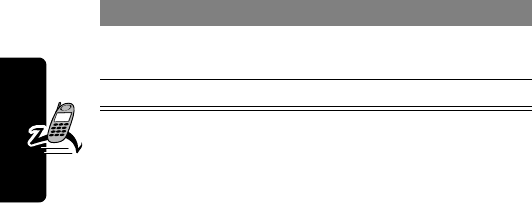
26
PRELIMINARY
Getting Started
Answering a Call
To answer a call, your phone must:
•
be turned on with the phone unlocked
•
have a SIM card inserted and unlocked
•
have a network connection with adequate signal
strength
When you receive a call, your phone rings and/or vibrates
and displays an incoming call message.
Press To
1
N
or
ANSWER
(
+
)
answer the call
2
O
(end key) end the call when it is done
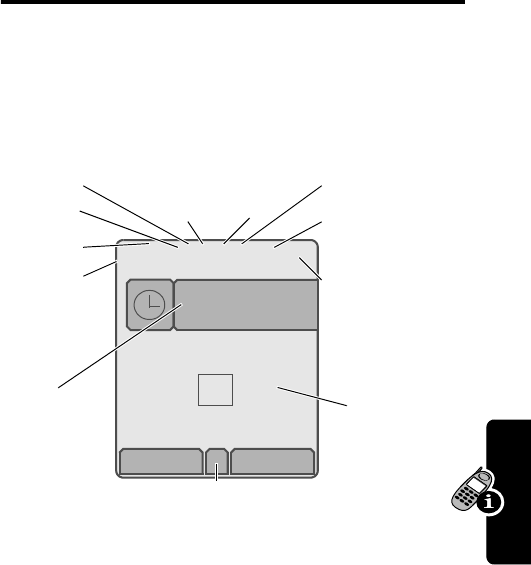
27
PRELIMINARY
Using Your Phone
Using Your Phone
See page 1 for a diagram of your phone that describes
basic phone components.
Display Symbols
!
Signal Strength Indicator
Shows the strength of your
device’s connection with the network.
You cannot make or answer calls when the “no signal”
indicator is displayed.
Strong
5
4
3
2
1
j
No signal
12:00
1/1/02 12:00
STYLES RECENT
M
\
{}
|
v
-d
:
5vGkW õY x E
Clock
"
Service
#
Signal
Security
$
Current
Line
When the Menu Indicator (
M
) appears, you can press
M
to open a menu. See “Using the Menu” on page 30.
%
Roam
&
Battery
Level
'
Text
Entry
(
Alert Type
)
Message
!
Signal
Strength
Icon Menu
(see page 30)

28
PRELIMINARY
Using Your Phone
"
Service Indicator
Indicates when a GPRS
connection is available. Your service provider
may indicate that a GPRS packet data
connection is active. This type of connection
may be used by your service provider to allow faster data
transfer speeds.
#
Signal Security Indicator
Indicates when you have a
secure connection for packet data transfers, embedded
application connections, or circuit switch data calls.
%
Roam Indicator
Indicates when your device
uses your home network (
K
) or another network
(
k
). When you leave your home network area,
your device roams or seeks another network.
$
Current Line Indicator
Tells you when you have Voice
Privacy on, a call in progress, or Call Forwarding on. This
icon also tells you which line is active (if you have a call on
hold), and whether you have Caps Lock, Numeric Entry, or
Symbol Entry switched on (when entering text).
'
Text Entry Indicator
Indicates your Text Entry
Method whenever you are in a text editor (Tap, iTap,
etc.). See “Entering and Editing Text” on page 33.
)
Message Indicator
Indicates when you
have a new voice or text message waiting.
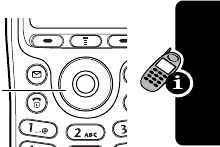
29
PRELIMINARY
Using Your Phone
(
Alert Type Indicator
Shows the current selected alert
profile. The default alert setting is a ringer.
&
Battery Level Indicator
Shows the amount of charge
left in your battery. The more bars visible, the greater the
charge.
Recharge your battery as soon as possible when you see
the
Low Battery
warning message and hear the low battery
alert.
Note:
When you charge the battery, the battery level
indicator instead shows how much of the charging process
is complete. See “Charging the Battery” on page 20.
Using the
4-Way
Navigation
Key
Use the 4-way navigation keys like a joystick to navigate
the menu system, change feature settings, and play
games.
w
= loud ring
x
=soft ring
y
=vibrate
u
= ring and vibrate
t
= silent
High
E
D
C
B
Empty
4-way
navigation
key

30
PRELIMINARY
Using Your Phone
Tip:
Down and up are your primary movements within
menus. Move left and right to change feature settings,
navigate the datebook, and edit text.
Using the Message and
Browser Keys
Your phone has special keys that give you access to
important features. Your Messages key (
K
) instantly
opens your messages, while your Browser key (
L
) opens
a Web session. You can use these keys any time you are
not on a call.
Using the Menu
Using the Icon Menu
When your phone is idle, it displays four easy-access
icons. The following icons may appear, depending on your
service provider and service subscription options.
To change this menu, see “Customizing Menus and
Display” on page 63.
Press
S
up to select the icon on the top, press
S
left to
select the icon on the left, and so on. You can also press
the right or left soft keys (
+
) to select the program
named in the display just above the key.
vMedia Center /Settings rPhonebook
-Games & Apps BWeb Access UMessages
dRing Styles jServices zRecent Calls
:Shortcuts >Extras nQuick Menu
mOffice Tools FWeb Sessions

31
PRELIMINARY
Using Your Phone
Navigating Through the Menu
This guide shows you how to navigate to a specific menu
feature as follows:
The > symbol means that you should scroll to and select
the feature. This example shows that you must press
M
,
scroll to and select
Media Center
, then scroll to and select
Pictures
to view a picture stored on your phone.
Setting Up Your Phone
You can adjust a wide variety of phone settings to suit your
needs.
Setting the Time and Date
Choosing Alert and Ring Tones
Your phone rings or vibrates to notify you of an incoming
call, message, or other event. This ring or vibration is
called an alert. The alert setting indicator in your display
shows the current alert profile (see illustration on page 27).
Find the Feature
M
>
Media Center
>
Pictures
Find the Feature
M
>
Settings
>
Other Settings
>
Initial Setup
>
Time and Date

32
PRELIMINARY
Using Your Phone
Select an Alert Profile
Customize an Alert Profile
Tip:
This feature lets you set the profile’s ringer volume
and keypad volume.
Setting Your Backlight
You can set the amount of time that the display backlight
remains on, or turn off the backlight to conserve battery
power:
Setting Display Animation
You can turn animation off (to conserve the battery) or
on. Animation makes your phone’s menus move
smoothly as you scroll up and down.
Find the Feature
M
>
Ring Styles
>
Alert
>theprofileyouwant
Find the Feature
M
>
Ring Styles
>Alert
Detail
>the event
>thealertyouwant
Find the Feature
M
>
Settings
>
Other Settings
>
Initial Setup
>
Backlight
Find the Feature
M
>
Settings
>
Other Settings
>
Initial Setup
>
Animation

33
PRELIMINARY
Using Your Phone
Entering and Editing Text
Various text entry methods make it easy for you to enter
names, numbers, and text messages on your phone.
Choosing a Text Mode
To activate a text mode, press
M
from any text entry
screen and select the text mode from the
Entry Method
menu:
Note:
The text mode you select remains active until you
change it by selecting another mode.
General Text Entry Rules
Use the keypad to enter letters, numbers, symbols, and
other characters with the tap method. Press the same key
repeatedly to cycle through available characters. (See the
“Character Chart” on page 34.)
iTAP
Let the phone predict each word as
you enter it, then choose the word
from a list.
Tap
Enter characters one at a time by
pressing the key for the letter, number,
or symbol. This is the standard mode
for entering text on your phone.
Numeric
Enter only the number that appears on
each key.
Symbol
Enter symbols only.
Browse
Browse through your phonebook and
recent calls lists to select a name or
number to enter.
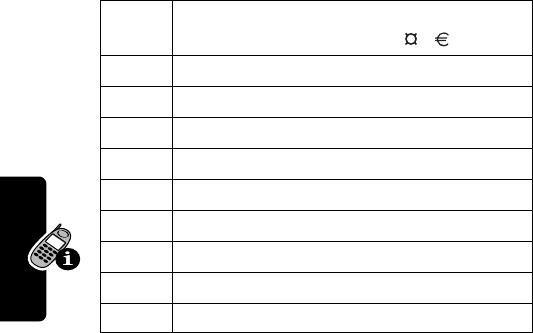
34
PRELIMINARY
Using Your Phone
•
If you do not press a key for two seconds, the
character in the block cursor is accepted, and the
cursor moves to the next position.
•
The first character of each sentence is capitalized
unless you manually change it. (Press
S
down to
force the character to lowercase while it is highlighted
by the block cursor.)
Character Chart
Use this chart as a guide for entering spaces, numbers,
letters, symbols, and other characters with the tap method.
Your phone model may not include all of the characters
shown in the above chart.
Copying, Cutting, and Pasting Text
You can copy, cut, and paste characters in the text and
number editors.
1
space . 1 ? ! , @ _ & ~ : ; "
- ( ) ' ¿ ¡ % £ $ ¥
2
a b c 2 ä å á à â ã
α
β
ç
3
d e f 3
δ
ë é è ê
φ
4
g h i 4 ï í î
γ
5
j k l 5
λ
6
m n o 6 ñ ö ø ó ò ô õ
ω
7
p q r s 7
π
ß
σ
8
t u v 8
θ
ü ú ù û
9
w x y z 9
ξ ψ
0
+ - 0 x * / \ [ ] = > < # §
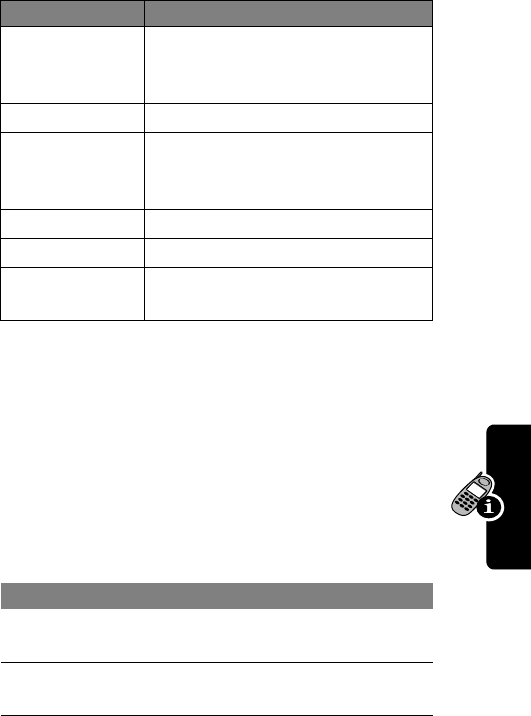
35
PRELIMINARY
Using Your Phone
In an editor, press
M
to see the following options:
Note:
The
Copy All Text
option also appears in the menu
(press
M
) when you are viewing details for a Phonebook
entry, Datebook event, Browser page, Text Message, or
Recent Calls entry.
Highlighting Text
In a text editor, to highlight and copy or cut text:
Option Description
Copy Text
tells your phone to copy the text
you are about to highlight (see
“Highlighting Text” below)
Copy All Text
copies all text in the editor
Cut Text
tells your phone to cut the text you
are about to highlight (see
“Highlighting Text” below)
Cut All Text
cuts all text in the editor
Paste
pastes the text you cut or copied
Undo
undoes the last copy, cut, or paste
action in the current text editor
Find the Feature
M
>
Copy Text
or
Cut Text
Press To
1
S
scroll to the beginning of the
text you want to copy or cut
2
START
(
+
) turn on the highlighting
marker
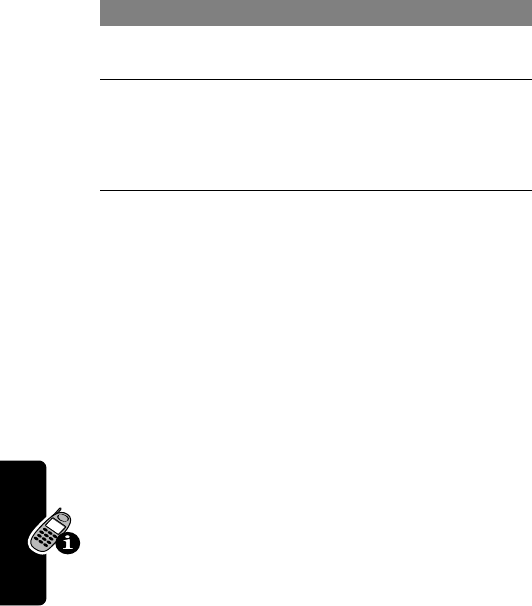
36
PRELIMINARY
Using Your Phone
Text remains on your clipboard, available to paste, until
you copy or cut other text or until you turn off your phone.
3
S
scroll to the end of the text
you want to copy or cut
4
COPY
(
+
)
or
CUT
(
+
)
copy or cut the text, as you
selected
You can now paste the text in
another text editor.
Press To
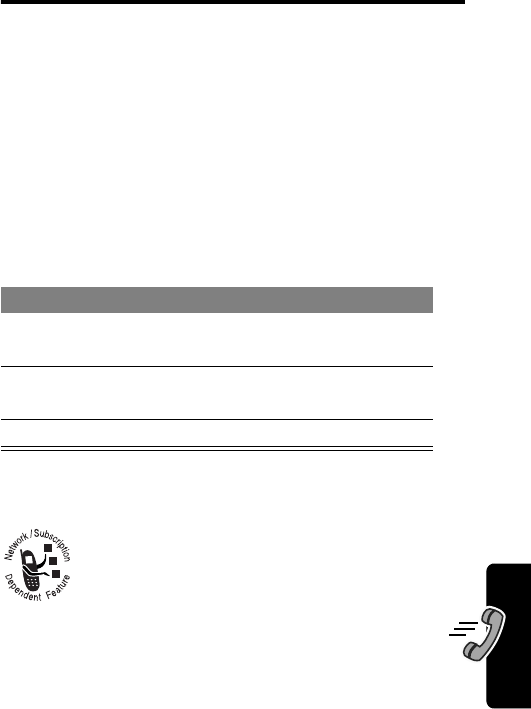
37
PRELIMINARY
Calling Features
Calling Features
This chapter describes features related to making and
answering calls. For information about other call-related
features, see “Viewing Recent Calls” on page 40 and
“Data Calls” on page 72. For basic instructions on how to
make and answer calls, see pages 25–26.
Redialing a Number
You can redial a previously dialed phone number, whether
the call was connected or busy. From the idle display:
Using Caller ID
The calling line identification (caller ID) feature
lets you see who is calling before you answer. If
the caller’s name is stored in your
phonebook, the phone automatically
displays the
Name
.
•
If caller ID information is not available, your phone
displays the message
Incoming Call
.
Press To
1
N
go directly to the dialed calls
list
2
S
scroll to the entry you want to
call
3
N
redial the highlighted number
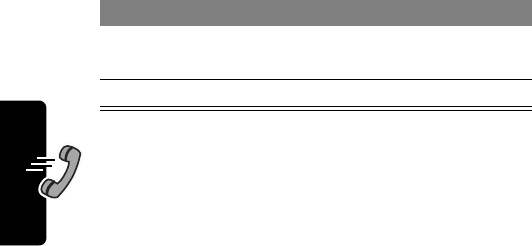
38
PRELIMINARY
Calling Features
•
While dialing (with digits visible in the display),
Press
M
>
Hide ID/Show ID
to Hide (or show) your
caller ID for the next call
Dialing an Emergency Number
Your service provider may program one or more
emergency phone numbers, such as 911, that you can call
under any circumstances, even when your phone is locked
or the SIM card is not inserted. Your service provider can
program additional emergency numbers into your SIM
card. However, your SIM card must be inserted in your
phone in order to use the numbers stored on it. See your
service provider for additional information on this issue.
Note:
Emergency numbers vary by country. Your phone¹s
preprogrammed emergency number(s) may not work in all
locations, and sometimes an emergency call cannot be
placed due to network, environmental, or interference
issues.
To call the emergency number at any time:
Press To
1
keypad keys dial the emergency number
(such as 112)
2
N
call the emergency number
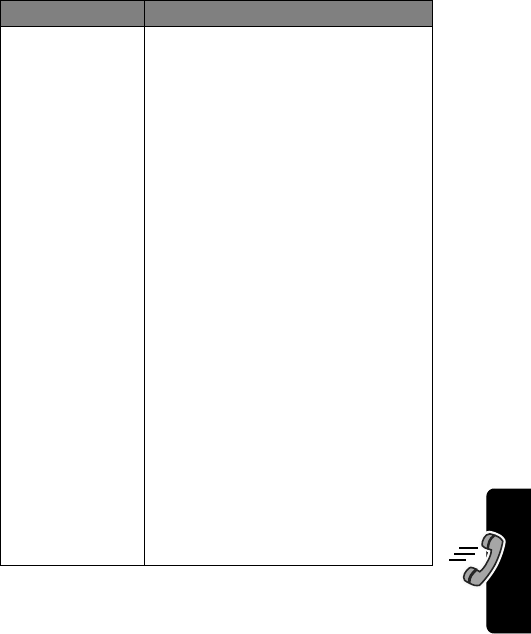
39
PRELIMINARY
Calling Features
Inserting Special Characters
into Dialing Sequences
While dialing (with digits visible in the display):
Do This To
Press
M
and
then scroll to
and select one
of the following:
•
Insert Pause
(to insert
a
p
)
•
Insert Wait
(to insert
a
w
)
•
Insert 'n'
(to insert
an
n
)
insert a special character when
making a call that requires you to
enter additional digits (for
example, to make a calling card
call, or to retrieve messages from
an answering machine):
• Pause
tells your phone to
wait until the call connects
before it automatically dials
the next digit(s) in a series.
•Wait
tells your phone to wait
until the call connects, and
then to prompt you for
confirmation before it dials
the next digit(s).
•'n'
tells your phone to prompt
you for a number before
dialing the call. The number
you enter is inserted into the
dialing sequence in place of
the
n
character.
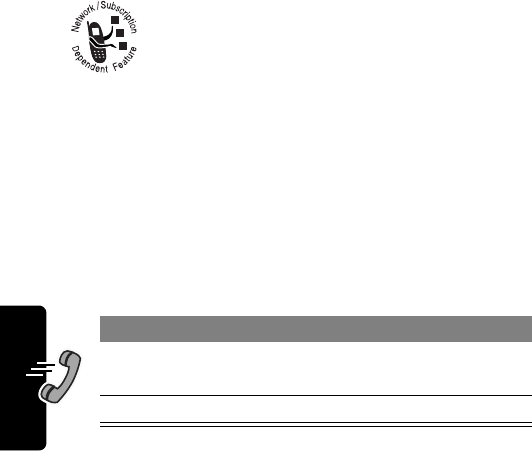
40
PRELIMINARY
Calling Features
Viewing Recent Calls
You can view and call numbers from calls you recently
dialed or received:
Press
N
to dial the entry displayed.
Using Voicemail
You can listen to your voicemail messages by
calling your network voicemail phone number.
Voicemail messages are stored on the
network—not on your phone. Contact your
service provider for more details.
Storing Your Voicemail Number
Store your voicemail number in your phone to make it
faster and easier to use voicemail. Your voicemail number
is provided by your service provider.
Find the Feature
M
>
Recent Calls
>
Received Calls
or
Dialed Calls
>entry to see
Find the Feature
M
>
Messages
M
>
VoiceMail Setup
Press To
1
keypad keys enter the phone number for
your voicemail
2
OK
(
+
) store the number
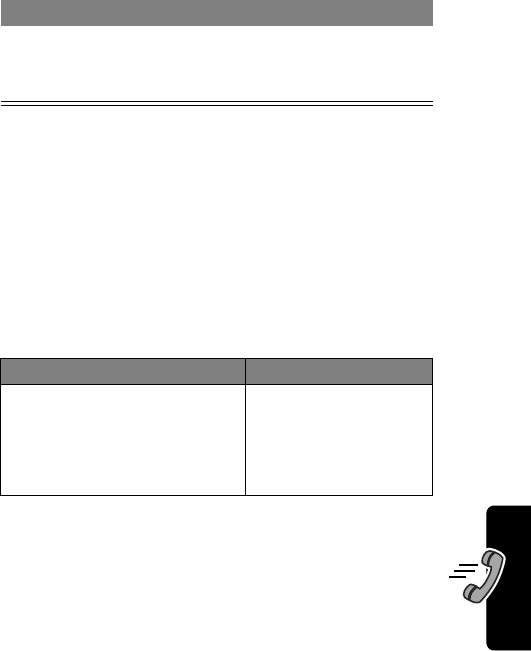
41
PRELIMINARY
Calling Features
Receiving a New Voicemail Message
When you receive a voicemail message, your phone
displays
New VoiceMail &
.
Listening to a Voicemail Message
To listen to your voicemail messages at any time:.
Voice Dialing
To voice dial a phone number or Email address stored in
your phonebook:
Do This To
Press
CALL
(
+
) call your voicemail phone
number and listen to the
message
Find the Feature
M
>
Messages
>
VoiceMail
Do This To Call
Press and release the voice
key, then say a voice name
a phonebook entry
using voice dial
To record a voice
name, see page 56.
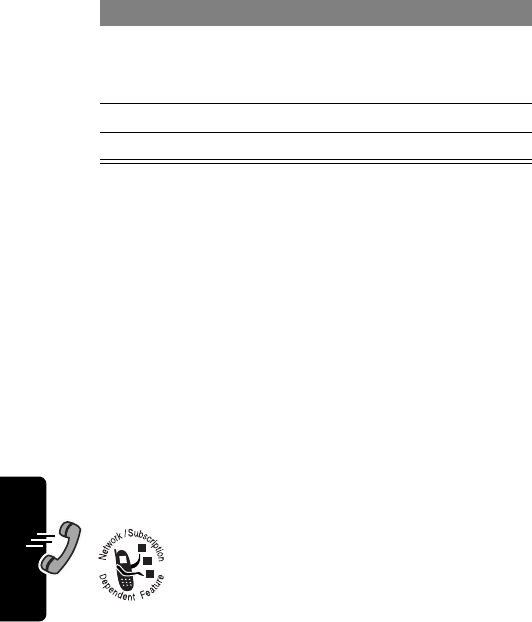
42
PRELIMINARY
Calling Features
Speed Dialing
When you store an entry in your phonebook, it is assigned
a unique speed dial number. You can then use the speed
dial feature to call the entry.
1-Touch Dialing
You can call phonebook entries 1 through 9 with the push
of a single key. Press and hold the one-digit speed dial
number for one second. You must Assign the 1-touch dial
feature to numbers 1 through 9 in your phone memory
phonebook or SIM card phonebook:
Using Call Waiting
If you subscribe to call waiting, an alert tone
sounds while you are on a call to indicate
that you have received a second call.
Press To
1
keypad keys enter the one-, two-, or
three-digit speed dial number
for the entry you want to dial
2
#
submit the number
3
N
call the entry
Find the Feature
M
>
Settings
>
Other Settings
>
Initial Setup
>
1-Touch Dial
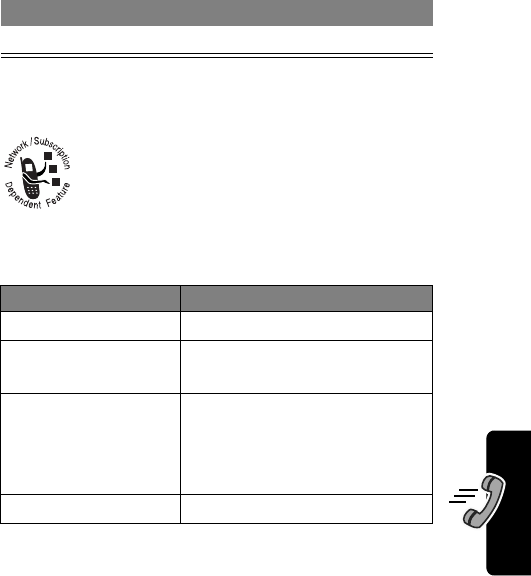
43
PRELIMINARY
Calling Features
To activate or deactivate call waiting:
To put the first call on hold and answer the second call:
Forwarding a Call
Call forwarding sends your phone’s incoming
voice, and/or data calls directly to another
phone number.
The call forwarding options for voice or data calls are:
Find the Feature
M
>
Settings
>
Other Settings
>
In-Call Setup
>
Call Waiting
Press To
1
N
answer the new call
Find the Feature
M
>
Settings
>
Call Forward
Option Description
All Calls
forwards all calls
If Unavailable
forwards calls if your phone is
unavailable
Detailed
uses different forwarding
numbers if you are out of
range, unable to answer, or
busy (voice calls only)
Off
does not forward calls
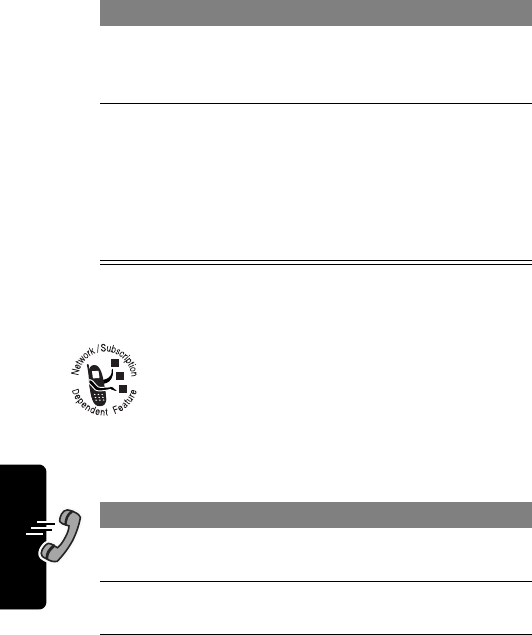
44
PRELIMINARY
Calling Features
Transferring a Call
You can directly transfer a call without talking to the person
who answers.
Barring a Call
Call barring lets you restrict outgoing or
incoming calls. You can restrict all calls, calls to
international numbers, or calls while roaming.
Find the Feature
M
>
Transfer
Press To
1
keypad keys enter the phone number
where you are transferring
the call
2
N
dial the phone number
Your phone displays the
message
Transfer: Complete
when the call is transferred.
You can hang up the phone
when you see this message.
Find the Feature
M
>
Settings
>
Security
>
Call Barring
Press To
1
S
scroll to
Outgoing
or
Incoming
calls
2
CHANGE
(
+
) select barring for
Outgoing
or
Incoming
calls
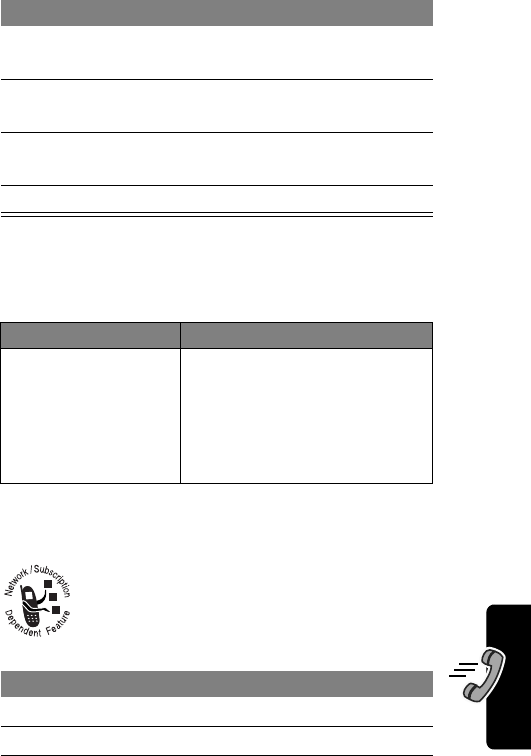
45
PRELIMINARY
Calling Features
Putting a Call on Hold
While you are on a call:
Making a Conference Call
To talk to more than one person on a call, you
can make a conference call. Call the first
person, call the second person, then link the
two calls.
3
S
scroll to a restriction for the
barred calls
4
SELECT
(
+
) select the restriction for the
barred calls
5
keypad keys enter your call barring
password
6
OK
(
+
) submit your password
Do This To
Press
HOLD
(
+
) (if
available)
or
Press
M
>
Hold
put a call on hold
Your phone displays a
l
(flashing phone) indicator to
indicate that the call is on
hold.
Press To
1
keypad keys dial the first person’s number
2
N
call the number
Press To
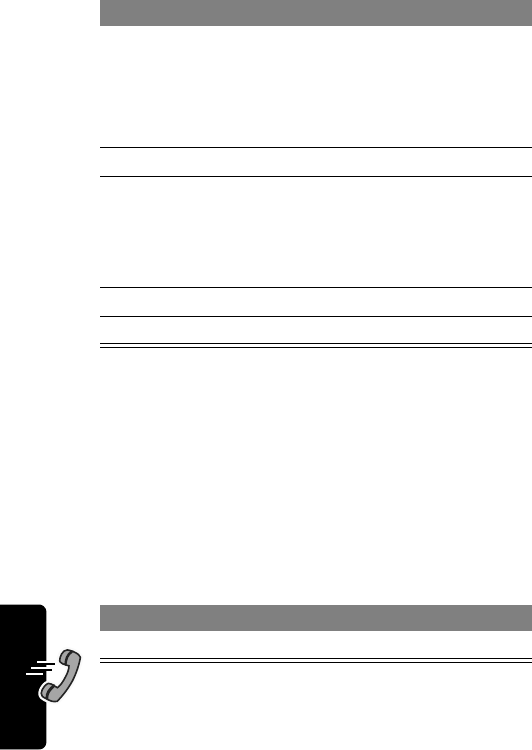
46
PRELIMINARY
Calling Features
Tip:
Repeat steps 3-6 to add additional parties to the
conference call.
Using Other Features During a
Call
During a call, you can easily switch to other phone
features or make a new Data,Browser, or Voice Call
connection:
The list of options includes phone applications, such as
Phonebook
and
Datebook
. It also includes any other
active connections you have, such as
Active Data Call
,
3
HOLD
(
+
)
(if available)
or
M
>
Hold
put the first call on hold
Your phone displays a
l
(flashing phone) indicator
next to the call on hold.
4
keypad keys dial the next person’s number
5
N
call the number
Your phone displays a
W
(active call) indicator next to
the new active call.
6
LINK
(
+
) connect the two calls
7
O
end the entire call
Press To
SWAP
(
+
) open a list of options
Press To
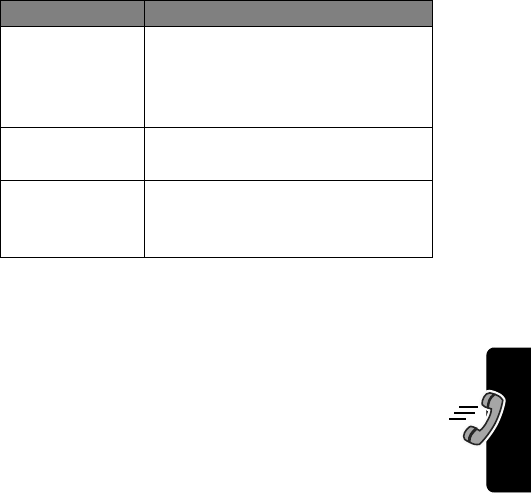
47
PRELIMINARY
Calling Features
Active Voice Call
, or
Active Browser
. To start a new voice call,
select
New Call
(this puts any current voice call on hold).
Changing Your Active Call Settings
You can view and change the number of call and data/
browser connections that your phone allows at one time:
The Active Calls list includes
Find the Feature
M
>
Settings
>
Connection
>
Active Calls
Option Description
No. of Calls
the number of active connections
your phone allows, which you can
increase to the number in the
Subscription
setting.
Subscription
the maximum number of active
connections you subscribed to
Network
the maximum number of active
connections your network
supports

48
PRELIMINARY
Messages and Email
Messages and Email
Text messages are brief messages that you
can send and receive (such as
Where are we
meeting?
). Received messages appear on
your phone display or in your text message
inbox.
You must set up the inbox before you can send and
receive these messages. Contact your service provider for
details.
Note:
Your service provider may have already
programmed the text message inbox settings for you.
Creating and Sending
Messages
You can create and send a message to one or more
recipients. The message feature lets you manually enter
each recipient’s phone number, or select one or more
numbers from the phonebook or recent calls lists. You can
also send a message to a Mailing List containing multiple
addresses (see “Storing a Phonebook Entry” on page 54
to create a Mailing List).
There are four different types of messages:
Short Message
,
Email
,
Letter
, and
Postcard
. For a description of the items in
each message type, see “Message Contents” on page 50.
Note:
When you manually enter multiple phone numbers
in the
To
field, you must insert a space between each
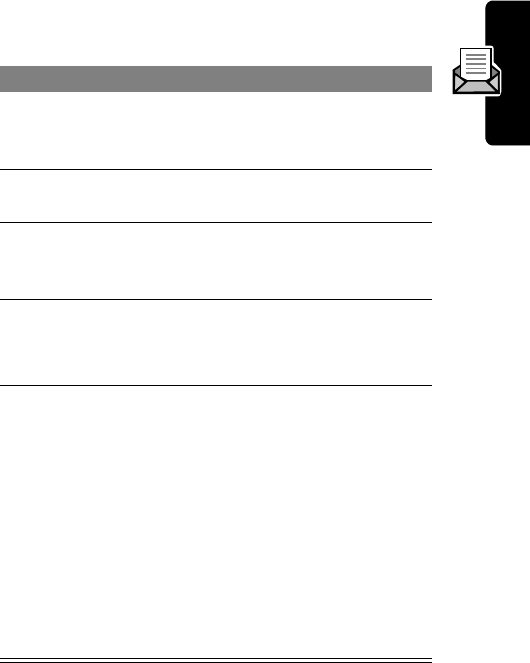
49
PRELIMINARY
Messages and Email
number. Press and hold
1
to insert a space as needed.
Find the Feature
M
>
Messages
M
>
Create Message
Press To
1
S
scroll to
New Short Message
,
New Email
,
New Letter
, or
New Postcard
2
SELECT
(
+
) select the type of message
you want to send
3
keypad keys complete the message
contents (see the table after
this procedure)
4
DONE
(
+
) finish the message
Your phone displays
Send Message Now?
5
YES
(
+
)
or
NO
(
+
)
send the message
Note:
Your phone sends
Email messages the next
time it checks your account,
or when you select
M
>
Messages
M
>
Send/Receive Mail
cancel the message or save it
as a
Draft
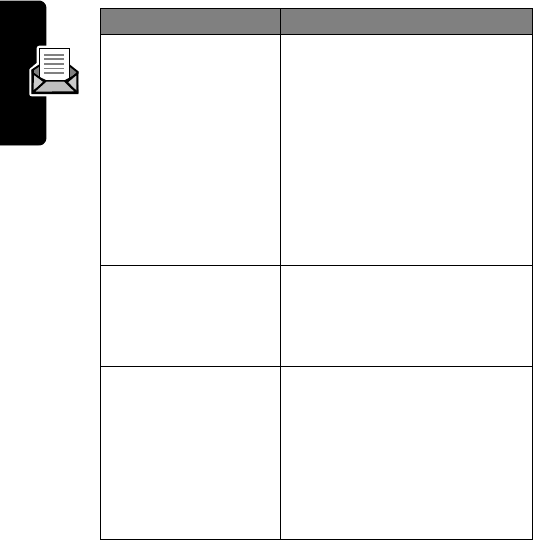
50
PRELIMINARY
Messages and Email
Message Contents
Item Description
To
(all message types)
one or more phone numbers
or email addresses where
you want to send the
message
You can press
BROWSE
(
+
) to
select one or more phone
numbers or email addresses
from the phonebook or recent
calls lists
CC
(Letter and Postcard
only)
phone numbers or email
addresses where you want to
send a carbon copy of the
message
BCC
(Letter and Postcard
only)
phone numbers or email
addresses where you want to
send a blind carbon copy of
the message (nobody can
see their address, and they
cannot see the other
addresses)
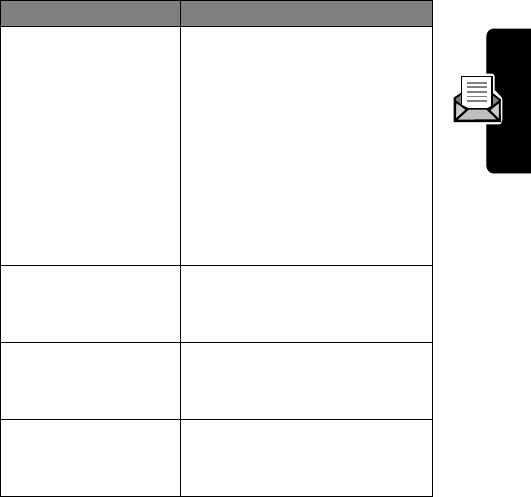
51
PRELIMINARY
Messages and Email
Viewing Message Status
Text messages that you send are stored in the outbox. To
view the contents of your outbox:
Messages are sorted from newest to oldest. The following
icons indicate message status:
Msg
(all message types)
the text message you enter
(see “Entering and Editing
Text” on page 33) or Postcard
you select
To insert a picture or other
object in Text, Email or Letter
messages, press:
M
>
Insert
> object type
>object
Subject
(Letter and Postcard
only)
the subject line of the
message
Priority
(not for
Short Messages)
the message priority
Receipt
(Letter and Postcard
only)
select a type of receipt you
want to receive after you
send the message
Find the Feature
M
>
Messages
>
Outbox
á
sending in
progress
Y
delivered
m
sending
failed
Item Description
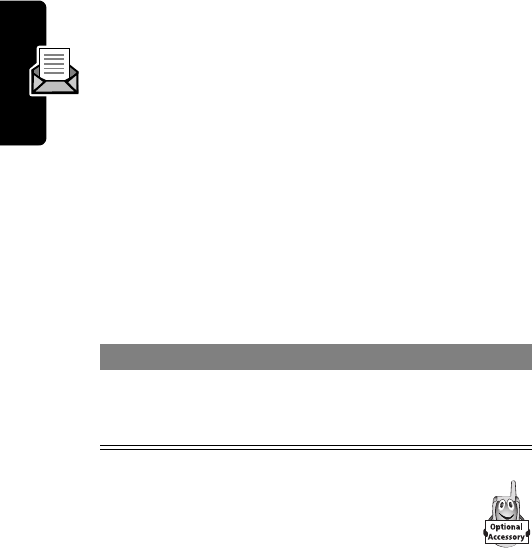
52
PRELIMINARY
Messages and Email
Note:
Some status indicators are not supported by Email
messages.
Receiving and Reading
Messages
Note:
Your phone checks for new
Email
messages
periodically, or whenever you select
M
>
Messages
M
>
Send/Receive Mail
When you receive a new message, your phone displays
New Message X
and gives an alert. When your inbox is full,
you must delete old messages before you can open new
ones.
From the new message notification:
Note:
If you receive a message with a file
attached, you can save phone memory by storing
the file on an SD/MMC card. See “Using an SD or
MMC Card” on page 75.
Press To
READ
(
+
) open the message (or your
text message inbox if there
are multiple messages)
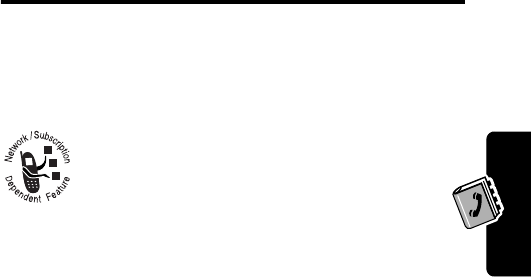
53
PRELIMINARY
Phonebook
Phonebook
You can store a list of names and phone numbers or email
addresses in your phone’s electronic phonebook. You can
view these entries and call them directly from your phone.
For email addresses, you can send a text
message directly from your phone.
To see the list of names stored in your
phonebook, press
M
>
Phonebook
from the
idle display. To show the entries in a category, see
“View Category Entries” on page 61.
Scroll to a name and press
VIEW
(
+
) to view details of the
phonebook entry as shown in the following display.
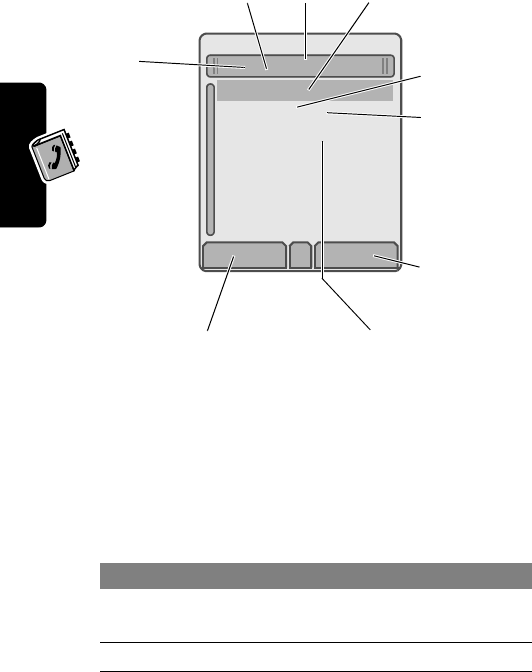
54
PRELIMINARY
Phonebook
Items in a Phonebook Entry
Storing a Phonebook Entry
Find the Feature
M
>
Phonebook
M
>
New
Press To
1
S
scroll to
Phone Number
,
Email Address
, or
Mailing List
2
SELECT
(
+
) select the type of entry
$*Carlo Emrys
01543372151410
Speed No.15# (P)
Ringer ID: Continental
BACK EDIT
M
5E
Type
indicator
identifies
number
type:
$
Work
U
Home
S
Main
h
Mobile
p
Pager
[
Email
Entry’s
Name
Edit
entry
Return
to list
Entry’s speed
dial number
(P)
indicates
entry stored
in phone
memory,
(S)
indicates
SIM memory
Voice Name
indicator
indicates a recorded
voice name
Press
M
to open the
Phonebook
Menu
Entry’s
phone number
,
email address
, or
mailing list
Entry’s ringer
ID setting
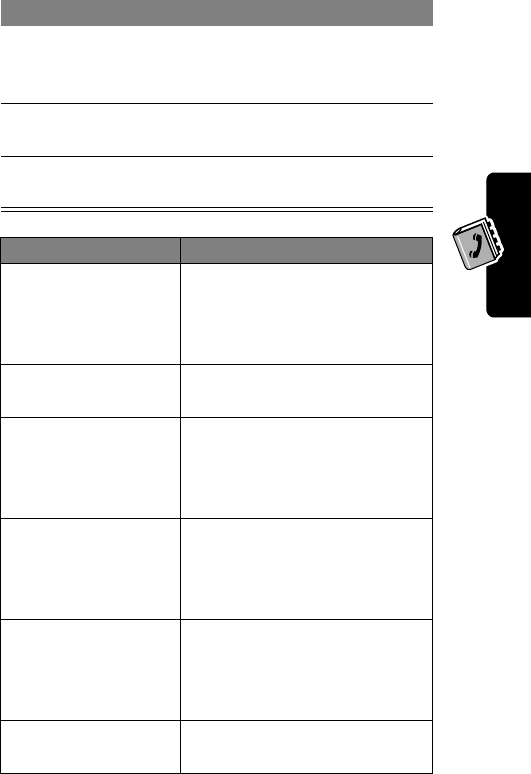
55
PRELIMINARY
Phonebook
3
S
scroll to the item you want to
enter (see the table that
follows this procedure).
4
CHANGE
(
+
) select the item and add,
select, or change information
5
DONE
(
+
) when
you are done
store the entry and return to
the phonebook list
Phonebook item Description
Name
enter a name for the
phonebook entry (see
“Entering and Editing Text” on
page 33)
Category
scroll to the category that
classifies the entry
No.
,
Email
, or
Members
enter the phone number or
email address, or select
phonebook entries to add as
members of the mailing list
Type
scroll to the type of phone
number (only for phone
numbers not stored on the
SIM)
Voice Name
record a voice name for the
entry. See “Recording a Voice
Name For a Phonebook
Entry” on page 56.
Speed No.
change the number you use
to speed dial the entry
Press To
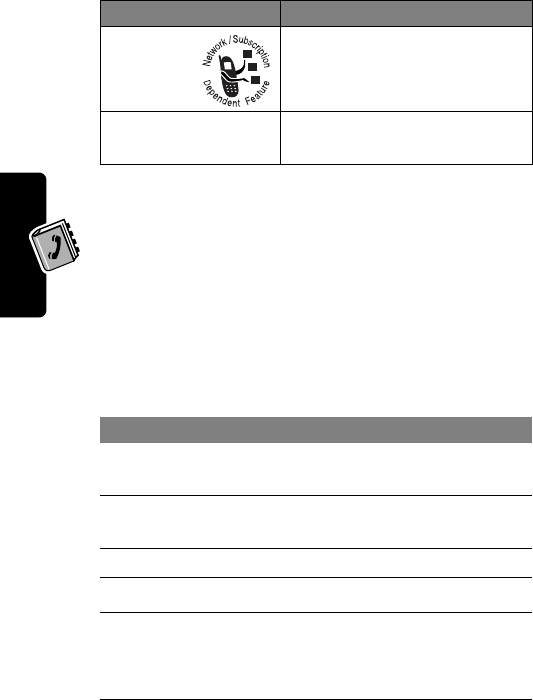
56
PRELIMINARY
Phonebook
Recording a Voice Name For
a Phonebook Entry
Tip:
Make your voice recording in a quiet location. Hold
the phone about four inches (10 centimeters) from your
mouth, and speak directly into the phone’s microphone in
a normal tone of voice.
Ringer ID
change the ring tone for calls
from this entry
More
create another entry with the
same
Name
Find the Feature
M
>
Phonebook
Do This To
1
Press
S
scroll to the entry that needs
a voice name
2
Press
VIEW
(
+
) display the entry’s detailed
view
3
Press
EDIT
(
+
) edit the phonebook entry
4
Press
S
scroll to
Voice Name
5
Press
RECORD
(
+
)
begin the recording process
The phone displays
Press
RECORD Key then say name
.
Phonebook item Description
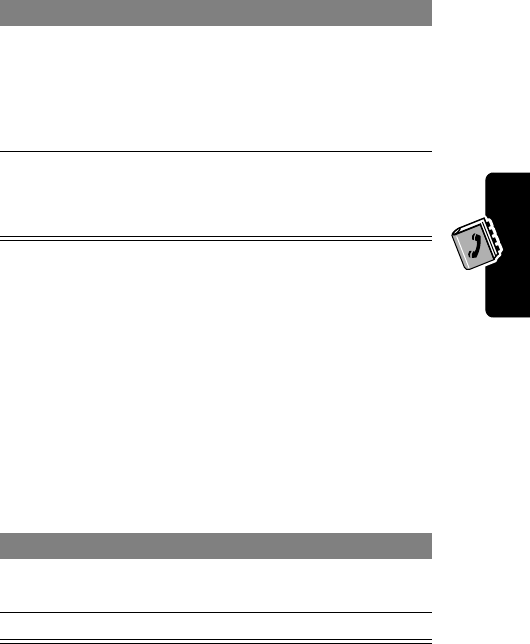
57
PRELIMINARY
Phonebook
Dialing a Phonebook Entry
You can use the phonebook list, voice dial, speed dial, or
1-touch dial to call a number stored in your phonebook. To
use speed dial, see “Speed Dialing” on page 42. To use
1-touch dial, see “1-Touch Dialing” on page 42.
Phonebook List
To call a number in the phonebook list:
Editing a Phonebook Entry
You can edit a phonebook entry stored on your phone or
the SIM card.
6
Press and
release
RECORD
(
+
) and say
the entry’s name
(in two seconds)
record the voice name
The phone displays
Press
RECORD Key then REPEAT name
.
7
Press the voice
key and repeat
the name
confirm the voice name
The phone displays
Trained:
Voice Name
.
Find the Feature
M
>
Phonebook
Press To
1
S
scroll to the entry you want to
call
2
N
make the call
Do This To
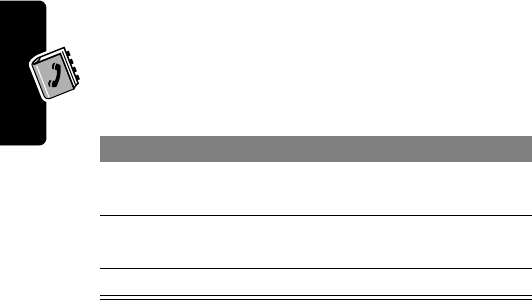
58
PRELIMINARY
Phonebook
Notes:
•
If you change an entry’s speed dial number, the entry
is moved to the new speed dial location and the
original entry is deleted. Entries with a speed dial
number from 1 to 500 are stored on the phone.
Entries with a speed dial number of 501 or higher are
stored on the SIM card.
•
You can also use the following procedure to edit a
fixed dial entry by selecting
M
>
Services
>
Fixed Dial
.
Edit a phonebook entry or fixed dial entry by following the
procedures described in “Storing a Phonebook Entry” on
page 54.
Deleting a Phonebook Entry
To delete a phonebook entry:
Find the Feature
M
>
Phonebook
Press To
1
S
scroll to the entry you want to
edit
2
VIEW
(
+
) display the entry’s detailed
view
3
EDIT
(
+
) edit the phonebook entry
Find the Feature
M
>
Phonebook
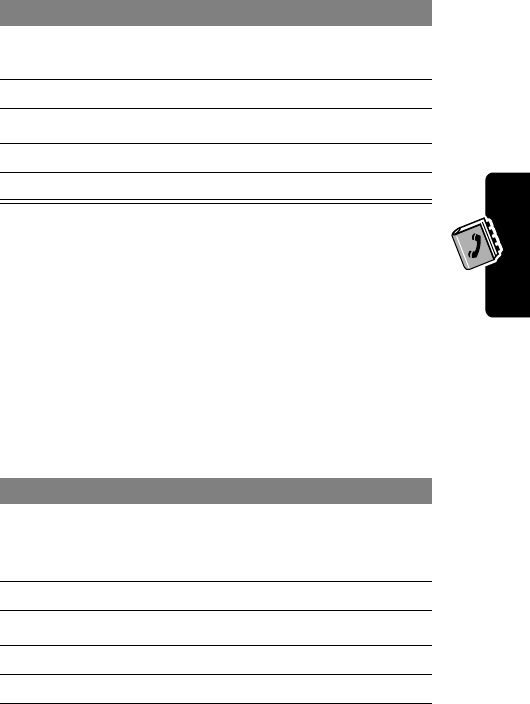
59
PRELIMINARY
Phonebook
Using Phonebook Categories
Phonebook categories let you use special ring tones
and backlight colors for phonebook entries you classify as
“Business,” “Personal,” “General,” or other categories.
Create or Edit a Category
Press To
1
S
scroll to the entry you want to
delete
2
M
open the
Phonebook Menu
3
S
scroll to
Delete
4
SELECT
(
+
)select
Delete
5
YES
(
+
) confirm the deletion
Find the Feature
M
>
Phonebook
M
>
Categories
Press To
1
S
scroll to a category to edit
(select any category if you
are creating a new one)
2
M
open the Categories menu
3
S
scroll to
New
or
Edit
4
SELECT
(
+
)select
New
or
Edit
5
CHANGE
(
+
) select the category
Name
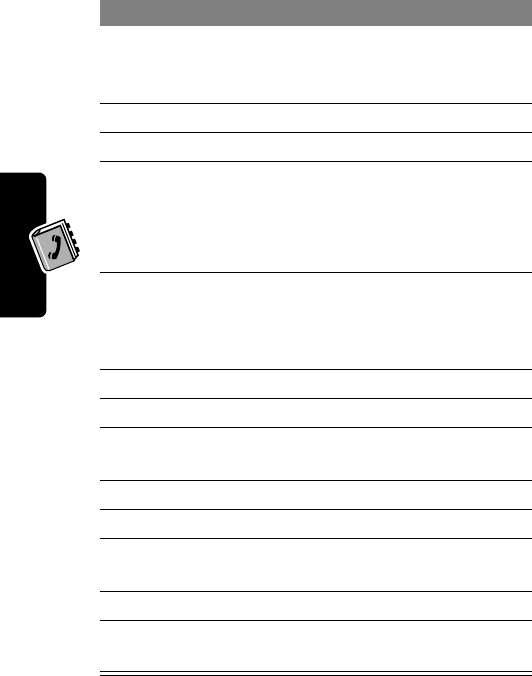
60
PRELIMINARY
Phonebook
6
keypad keys enter the category name (see
“Entering and Editing Text” on
page 33)
7
OK
(
+
) store the category name
8
CHANGE
(
+
) open the member list
9
S
scroll to a phonebook entry
you want to add or remove
Note:
You cannot add entries
stored on a SIM card.
10
ADD
(
+
)
or
REMOVE
(
+
)
add an unchecked entry
remove a checked entry
11
DONE
(
+
) close the member list
12
CHANGE
(
+
) select the category
Ringer ID
13
S
scroll to the ringer ID to use
for calls from category entries
14
SELECT
(
+
) select the ringer ID
15
CHANGE
(
+
) select the category
Backlight
16
S
scroll to the backlight color for
calls from category entries
17
SELECT
(
+
) select the backlight
18
DONE
(
+
) store the category and return
to the phonebook list
Press To
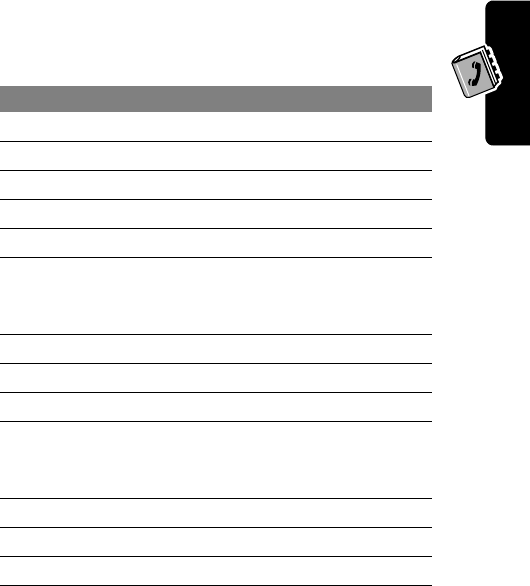
61
PRELIMINARY
Phonebook
View Category Entries
You can select a category to show only its entries:
Copy Multiple Entries
Find the Feature
M
>
Phonebook
M
>
Categories
>the category
you want to see
Find the Feature
M
>
Phonebook
Press To
1
M
open the
Phonebook Menu
2
S
scroll to
Copy Entries
3
SELECT
(
+
)select
Copy Entries
4
S
scroll to
From (start)
5
CHANGE
(
+
)select
From (start)
6
keypad keys enter the low speed dial
number for the range of
entries you want to copy
7
OK
(
+
) store the number
8
S
scroll to
From (end)
9
CHANGE
(
+
)select
From (end)
10
keypad keys enter the high speed dial
number for the range of
entries you want to copy
11
OK
(
+
) store the number
12
S
scroll to
To (start)
13
CHANGE
(
+
)select
To (start)
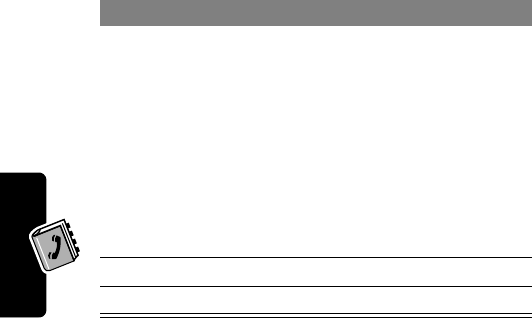
62
PRELIMINARY
Phonebook
14
keypad keys enter the low speed dial
number for the entries’ new
location
Note:
Enter a speed dial
number between 1-500 to
copy entries to the phone.
Enter a speed dial number of
501 or higher to copy entries
to the SIM card.
15
OK
(
+
) store the number
16
DONE
(
+
) copy the entries
Press To
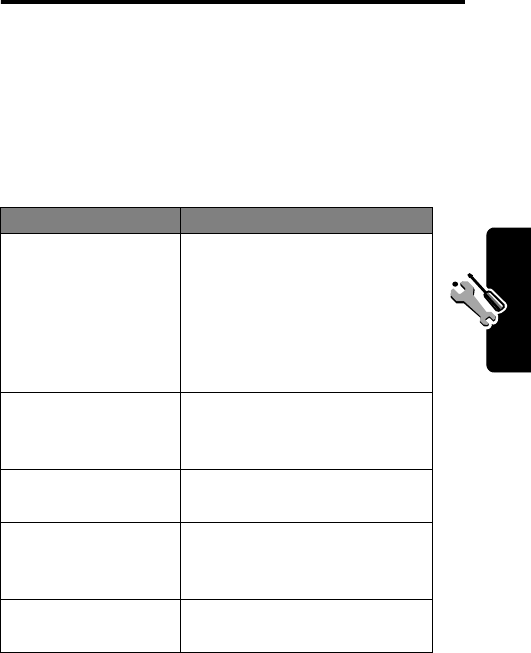
63
PRELIMINARY
Customizing Your Phone Settings
Customizing Your
Phone Settings
You can adjust a wide variety of phone settings.
Customizing Menus and Display
You can change settings for these features:
Find the Feature
M
>
Settings
>
Personalize
Setting Description
Main Menu
choose the Icon or List view,
and reorder your options
Note:
The first nine items
appear on the main menu.
The rest appear under
M
>
Extras
.
Keys
change the features linked to
your soft keys (
+
)and
S
when your phone is idle
Wallpaper
select your display’s
background image and layout
Screen Saver
select an image to appear
when your phone is idle, and
the amount of delay
Power Up
choose an image to appear
when you turn on your phone
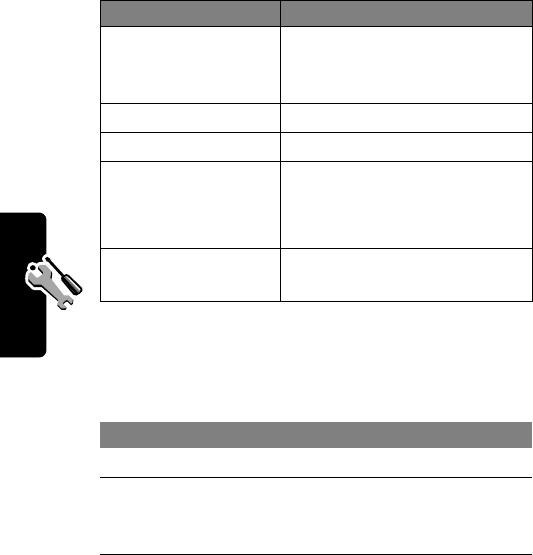
64
PRELIMINARY
Customizing Your Phone Settings
Using Shortcuts
The following shortcuts are pre-programmed in your
phone. You cannot edit or delete them.
You can add shortcuts for many menu features and
applications. Shortcuts takes you directly to the menu
item, or perform the menu action (if applicable).
Do This To
Press
M
, then
press and hold
M
(within two seconds)
zoom in/out your phone’s
display view
Press
M*
lock/unlock your keypad
Press
M#
display your phone number
Press
N
go to the dialed calls list
(See “Viewing Recent Calls”
on page 40.)
Press
O
exit the menu system, return
to the idle display
Do This To
1
Press
M
enter the menu system
2
Scroll to the item
you want to add
to Shortcuts
highlight the menu item
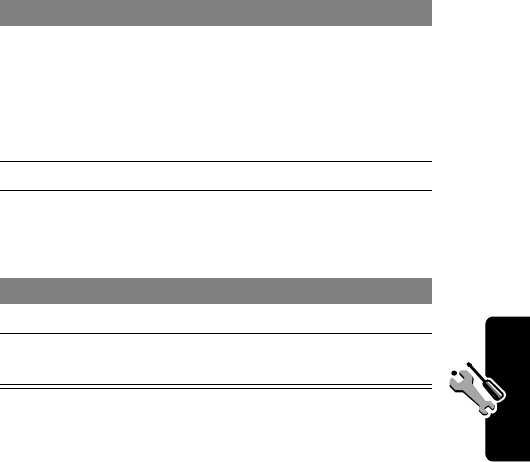
65
PRELIMINARY
Customizing Your Phone Settings
You can use shortcuts from the idle display, while on a call,
or while scrolling through a menu.
Setting Your Display Timeout
This is a power-saving feature that turns off your phone’s
display when it is inactive for a selected idle time. Your
display reactivates if you press a key or receive a call.
3
Press and hold
M
open the shortcut editor
The phone displays:
Assign Shortcut for:
Item
?
where Item is the name of the
item you selected.
4
Press
YES
(
+
) view your options
Press To
1
M
open the menu
2
the shortcut key
number
go to the menu item, or
perform the menu action
Find the Feature
M
>
Settings
>
Other Settings
>
Initial Setup
>
Display Timeout
>selected idle time
Do This To
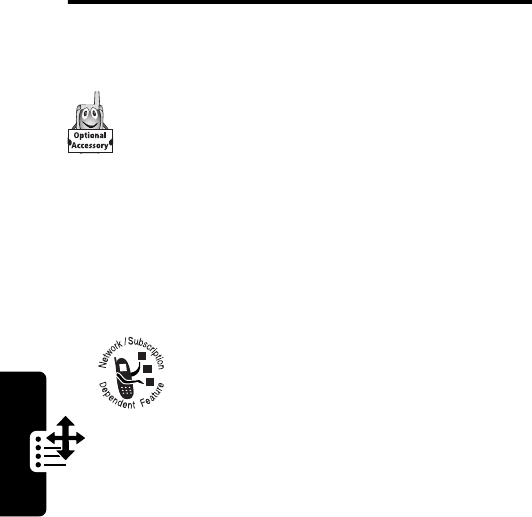
66
PRELIMINARY
Getting More Out of Your Phone
Getting More Out of
Your Phone
Using Hands Free Features
Your phone includes an integrated two-way
speakerphone for all hands free applications. You
can also purchase an optional Motorola Original™
Easy-Install or Pro-Install Hands Free Kit for your
car, or an optional Motorola Original phone headset.
These accessories provide alternative ways for you to use
your phone without using your hands.
Dialing Options
Fixed Dialing
When you activate the fixed dial feature,
users can only call the numbers in the fixed
dial list.
Fixed dial list entries can be any length. If there is a fixed
dial entry for the digits 555, users can call any number that
starts with 555. You must enter your SIM PIN2 code to edit
fixed dial entries.
Find the Feature
M
>
Settings
>
Security
>
Fixed Dialing
Find the Feature
M
>
Services
>
Fixed Dial
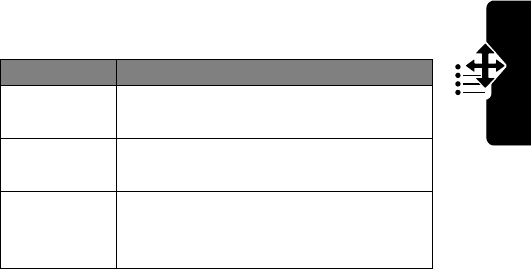
67
PRELIMINARY
Getting More Out of Your Phone
In the fixed dial list, you can create, edit, delete, and sort
entries just like in the phonebook list. Fixed dial list entries
are stored on your SIM card and do not have
Type
or
Voice Name
fields.
Monitoring Phone Use
Your phone tracks and records call times. Use the recent
calls menu to view and reset a call timer.
Network connection time is the elapsed time from the
moment you connect to your service provider’s network to
the moment you end the call by pressing
O
. This time
includes busy signals and ringing.
The amount of network connection time you track on
your resettable timer may not equal the amount of
time for which you are billed by your service provider.
For billing information, please contact your service
provider directly.
You can view the approximate network connection time
elapsed during the following calls:
Timer Description
Last Call
Time spent on the last call dialed or
received. You cannot reset this timer.
Dialed Calls
Total time spent on dialed calls since
the last time you reset this timer.
Received Calls
Total time spent on calls received
since the last time you reset this
timer.
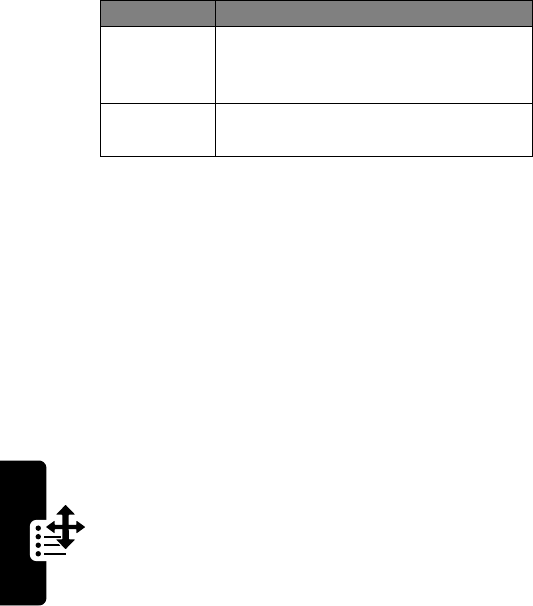
68
PRELIMINARY
Getting More Out of Your Phone
To view a call timer:
To reset a call timer, press
RESET
(
+
) while viewing it.
Network Features
Network Selection
You can view and adjust your phone’s network settings:
Your service provider registers your phone to a
network. You can view information about the current
network, change how your phone searches for a network,
specify your preferred networks, and activate alerts that
indicate when a call is dropped or network registration
changes.
All Calls
Total time spent on dialed and
received calls since the last time you
reset this timer.
Lifetime
Total time spent on all calls on this
phone. You cannot reset this timer.
Find the Feature
M
>
Recent Calls
>
Call Times
>thetimeryouwant
Find the Feature
M
>
Settings
>
Other Settings
>
Network
Timer Description
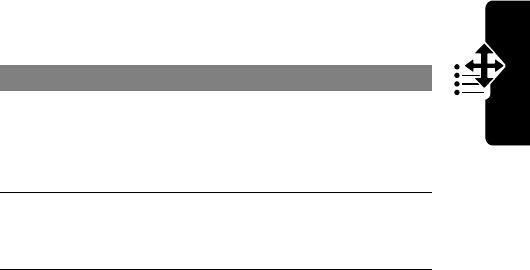
69
PRELIMINARY
Getting More Out of Your Phone
Connecting Your Phone to an
External Device
You can connect your phone to a computer or hand-held
device using a Bluetooth™ wireless connection, an
infrared wireless link, a serial cable, or a USB cable.
Note:
Not all devices are compatible with Bluetooth,
infrared, serial cable, or USB cable connections. Check
your external device for specifications.
Setting Up a Cable Connection
Attach a serial cable or Motorola Original USB cable to the
phone and external device as follows.
Note:
Check your computer or hand-held device to
determine the type of cable you need.
Attaching a Serial Cable
Use the interchangeable head on the Motorola
Multi-Connect Serial Cable to connect a computer, Palm III
device, or Palm V device to your phone.
Do This
1
Plug the serial cable into the detachable head.
Make sure that the Motorola logo on the
detachable head and the metal shielding on the
serial cable plug are both facing you.
2
With the Motorola logo and the phone both
facing you, plug the detachable head into your
phone’s accessory connector port.
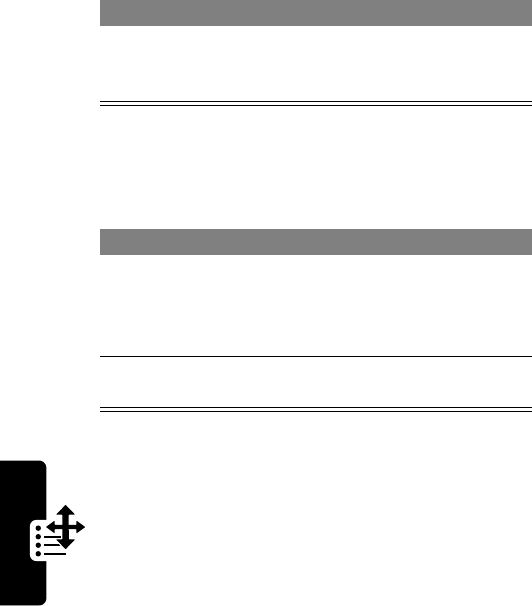
70
PRELIMINARY
Getting More Out of Your Phone
Note:
To save phone power when using a serial cable,
plug a charger into the charger slot on the cable head.
Attaching a USB Cable
Setting Up an Infrared Connection
Establish an infrared wireless data connection with an
external device as follows.
Notes:
•
This phone is classified as a Class 1 LED product
and is considered safe under reasonable use.
•
Your phone must be within one foot (30 centimeters)
of the other device. Nothing can block the line of sight
between the two devices.
•
You cannot set up an infrared connection when a
serial cable is attached to your phone.
3
Plug the other end of the cable into the serial
interface connection on the external device and
tighten the screws.
Do This
1
Plug the end of the cable with the Motorola logo
into your phone’s accessory connector port.
Make sure that the logo and the phone are both
facing you.
2
Plug the other end—the USB connection—into
the USB port on the external device.
Do This

71
PRELIMINARY
Getting More Out of Your Phone
If the phone does not find an infrared-capable device, it
changes the right soft key (
+
) from
STOP
to
START
.
To break the infrared data connection, press
STOP
(
+
).
You can also move the device away from the phone, turn
off the device, or turn off the phone. If your phone moves
away from a connected device while it is still on, it will try to
re-connect for 30 seconds after the connection breaks.
Setting Up a Bluetooth Connection
Before connecting your phone to another Bluetooth
device, set up the other device as described in its user
guide.
For a PC, set up the Bluetooth accessory card, card
drivers, and application software. If you want to use Dial-
up Networking Services, configure them for the Bluetooth
modem as described in the software and modem user
guides.
Find the Feature
M
>
Settings
>
Connection
>
IrDA Link
Press To
START
(
+
) activate the infrared link
Press To
START
(
+
) try another connection
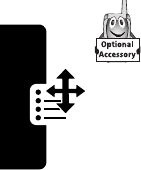
72
PRELIMINARY
Getting More Out of Your Phone
Connecting a Computer for a Data Call
Prepare your computer to set up the Bluetooth connection,
then make your phone available for the connection:
You have 60 seconds to start the connection from your
computer while your phone is available.
Turning Bluetooth On or Off
You can turn your phone’s Bluetooth feature on or off:
Data Calls
A Motorola Original™ data kit with a cable or a
Bluetooth™ wireless connection lets you
transfer data between your phone and a
computer or other external device. You can:
•
use your phone as a modem to connect to the
Internet.
•
use your phone to make and answer data calls on
your computer or hand-held device.
Find the Feature
M
>
Settings
>
Connection
>
Bluetooth Link
>
Setup
>
Find Me
Find the Feature
M
>
Settings
>
Connection
>
Bluetooth Link
>
Setup
>
Power
>
On
or
Off
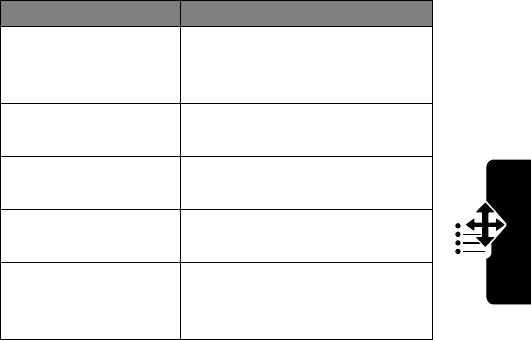
73
PRELIMINARY
Getting More Out of Your Phone
Using Sync
This feature lets you quickly synchronize your events and
Phonebook entries with a local computer, or with an
Internet server using a wireless connection.
Creating an Internet Sync Partner
To enter a computer as a Sync partner for your phone:
Your phone opens a
Partner Details
list:
Find the Feature
M
>
Settings
>
Connection
>
Sync
>
New
Detail Description
Partner Name
A common name you assign
to the computer (such as
“Work server”)
Server URL
The URL for the server (you
can omit “http://”)
User Name
Your user name for logging
into the server
Password
Your password for logging
into the server
(data)
Path
The name of the folder,
beneath the URL path, where
your data is stored

74
PRELIMINARY
Getting More Out of Your Phone
Using an Internet Sync Partner
To start synchronizing with a Sync partner:
Your phone attempts a Sync connection with the URL,
user name, and password you entered for the partner. This
might take several minutes, if there are many entries to
synchronize.
Using a Local Sync Partner
To use Sync with a local partner such as a connected
desktop computer, you must install Starfish TrueSync
®
software, a Motorola accessory product. See the TrueSync
user guide for more information.
Note:
TrueSync software is designed to synchronize with
basic features of many popular Personal Information
Management (PIM) software and hardware products.
Start the Sync action on the connected computer. To
connect a computer, see “Connecting Your Phone to an
External Device” on page 69.
Find the Feature
M
>
Settings
>
Connection
>
Sync
> partner name
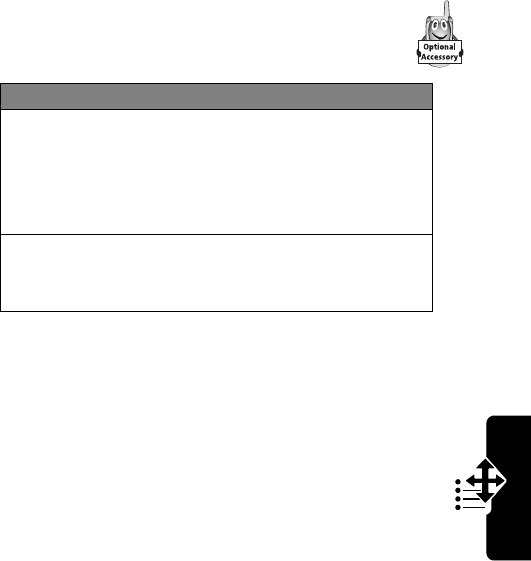
75
PRELIMINARY
Getting More Out of Your Phone
Using an SD or MMC Card
You can purchase Secure Digital or Multimedia
Cards to store or load large files such as videos,
pictures, or sound.
To store an item on your card, open it and press
STORE
(
+
), if available, or press
M
>
Store
. You can
store the file only, or make it a setting on your phone (such
as ring tone or wallpaper).
To remove a card, push it in to trigger the release
spring that ejects the card. The phone should push the
card out enough that you can grab it and pull it the rest
of the way out of the phone.
To Insert a Card
1
Insert the card in the slot in the side of your
phone (see the diagram on page 1).
Insert the narrow side with the cut corner first,
with the exposed pins facing the back of the
phone. Insert the card until it clicks in place.
2
Your phone should display the card contents or
(if new) ask you to format it. If it does not, select
M
>
Settings
>
Phone Status
> card name

76
PRELIMINARY
Security
Security
Line Security
If your phone displays
Line Not Secure
while you are on a
call, your phone has detected another device monitoring
the call. This message does not appear when caller ID,
call cost, or other information fills the display.
Locking and Unlocking Your
Phone
A locked phone still rings or vibrates for incoming calls or
messages, but you must unlock it to answer.
Lock Your Phone Manually
Set Your Phone to Lock Automatically
You can set your phone to lock every time you turn it off:
Changing Your Unlock Code
Your phone’s four-digit unlock code is originally set to
1234, and the six-digit security code is originally set to
Find the Feature
M
>
Settings
>
Security
>
Phone Lock
>
Lock Now
Find the Feature
M
>
Settings
>
Security
>
Phone Lock
>
Automatic Lock
>
On
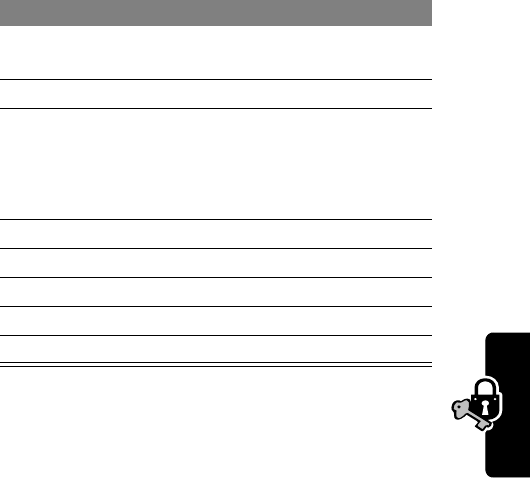
77
PRELIMINARY
Security
000000. Your service provider may reset these numbers
before you receive your phone.
If your service provider has not reset these numbers, we
recommend that you change them to prevent other users
from accessing your personal information or modifying
your phone settings. The unlock code must contain four
digits, and the security code must contain six digits. Be
sure to make a note of the new numbers.
Find the Feature
M
>
Settings
>
Security
>
New Passwords
Press To
1
S
scroll to the code or
password you want to change
2
CHANGE
(
+
) select the code or password
3
keypad keys enter your old code
If you do not know your code,
see “If You Forget Your
Unlock Code” on page 78.
4
OK
(
+
) submit your old code
5
keypad keys enter the new code
6
OK
(
+
) assign the new code
7
keypad keys re-enter the new code
8
OK
(
+
) confirm the new code
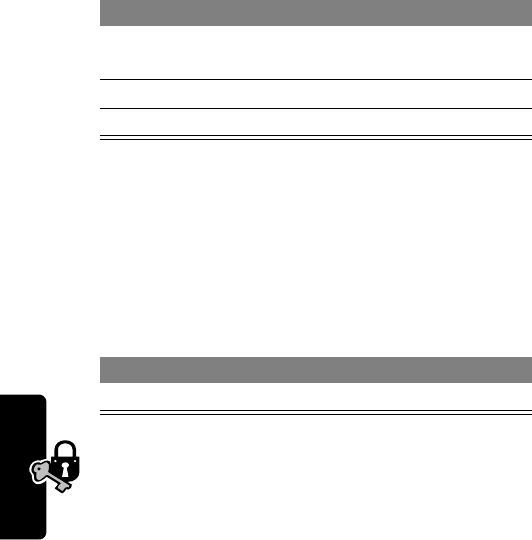
78
PRELIMINARY
Security
If You Forget Your Unlock Code
If you forget your security code (originally set to 000000),
SIM PIN, SIM PIN2, or call barring password, contact your
service provider.
If you forget your unlock code, try entering 1234 or the last
four digits of your phone number. If that does not work, do
the following when you see the
Enter Unlock Code
message:
Locking and Unlocking the
Keypad
This feature is useful in situations where an accidental
keypress might inadvertently dial an emergency number or
one-touch dial number (for example, when carrying your
phone in a purse or pocket).
Note:
Incoming calls and messages unlock the
keypad.
Press To
1
M
go to the unlock code bypass
screen
2
keypad keys enter your security code
3
OK
(
+
) submit your security code
Press To
M
*
lock or unlock your keypad

79
PRELIMINARY
Security
Protecting the SIM Card
When the SIM PIN feature is activated, you must enter
your SIM card PIN code each time you turn on the phone
or insert a SIM card. Contact your service provider for your
SIM card PIN code.
Unblock the SIM Card PIN Code
If you enter an incorrect SIM card PIN code three times in
a row, your SIM card is disabled and your phone displays
the message
SIM Blocked
. You need to enter a PIN
unblocking key (PUK) code, which you can obtain from
your service provider.
Find the Feature
M
>
Settings
>
Security
>
SIM PIN
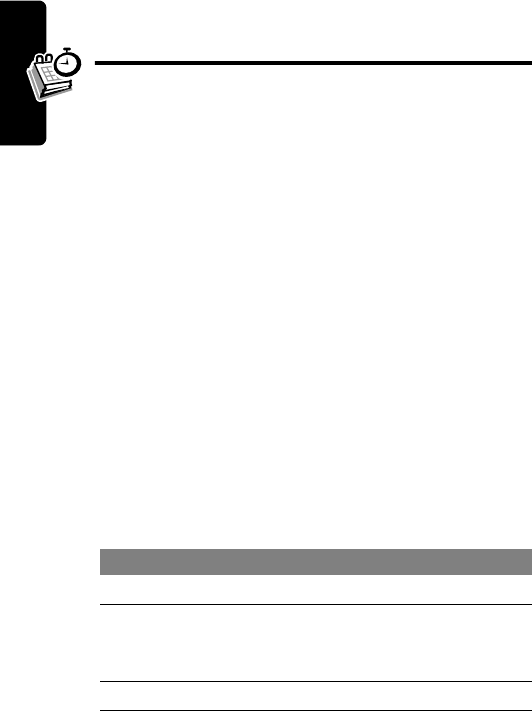
80
PRELIMINARY
Personal Organizer Features
Personal Organizer
Features
Datebook
The datebook is a calendar that lets you schedule and
organize events such as appointments and meetings. You
can review your schedule of events for the week or by the
day, and have your phone play a reminder alarm for
specific events.
Note:
You must set the correct time and date in order to
use the datebook (see “Setting the Time and Date” on
page 31).
Storing a New Event
A title is required for a datebook event. All other
information is optional.
Find the Feature
M
>
Office Tools
>
Datebook
> day
M
>
New
>
Event
Press To
1
CHANGE
(
+
) select
Title
2
keypad keys enter a title for the event (see
“Entering and Editing Text” on
page 33)
3
OK
(
+
) store the event title
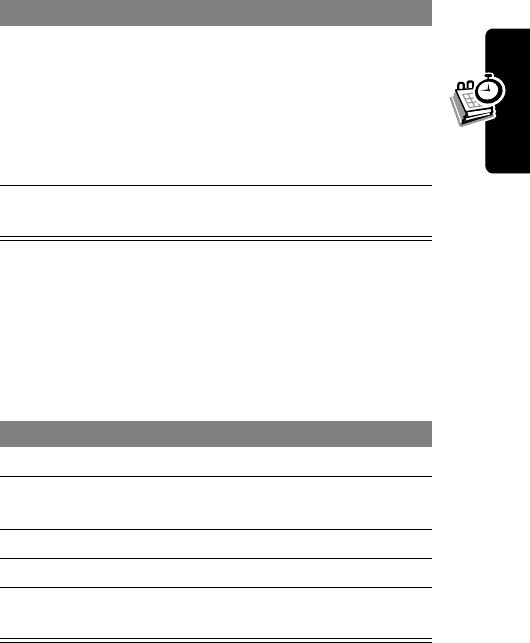
81
PRELIMINARY
Personal Organizer Features
Changing Event Information
To change information about an existing event:
4
S
scroll to other fields and enter
information as necessary
Other fields let you enter start
time, duration, date,
repeating events, and
reminder alarm.
5
DONE
(
+
) store the new event and
return to the day view
Find the Feature
M
>
Office Tools
>
Datebook
> day
>event
Press To
1
EDIT
(
+
) edit the event
2
S
scroll to the detail you want to
change
3
CHANGE
(
+
) edit the information
4
keypad keys enter the new information
5
DONE
(
+
) store the information and
return to the day view
Press To
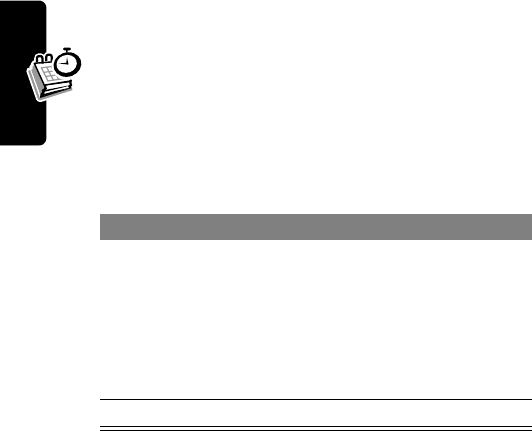
82
PRELIMINARY
Personal Organizer Features
Alarm Reminders
Reminders are alerts that ring or vibrate to notify you
about a voicemail or text message you have received,
or a datebook event you have scheduled.
To set or turn off reminders:
Voice Notes
You can use the voice note feature to record personal
messages and phone calls on your phone.
U.S. patent Re. 34,976
Record a Voice Note
Use this procedure to record a voice note from the idle
display, or to record a phone call in progress. Your phone
plays an alert tone to notify the other party that the call is
being recorded.
Find the Feature
M
>
Ring Styles
>Alert
Detail
>
Reminders
Press To
1
S
scroll to the reminder alert
you want:
Beep
,
Vibrate
, or
Off
Beep
or
Vibrate
sets the
corresponding reminder alert
type.
Off
turns off all
reminders.
2
SELECT
(
+
) select the reminder alert
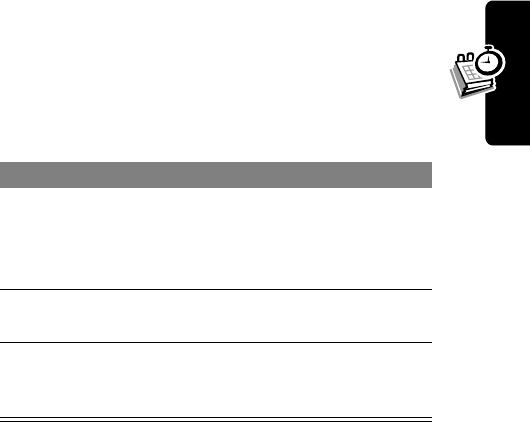
83
PRELIMINARY
Personal Organizer Features
Note:
Recording phone calls is subject to varying state
and federal laws regarding privacy and recording of
conversations.
Tip:
Make your recording in a quiet location. Hold the
phone about four inches (10 centimeters) from your
mouth, and speak directly into the phone’ in a normal
tone of voice.
View the Voice Notes List
Do This Result
1
Press and hold the
voice key for the
duration of the
recording.
The phone sounds an
alert tone and begins
recording.
2
Speak your voice note. The phone records the
voice note.
3
Release the voice key
to stop recording.
The phone displays the
voice note number and
total recording time.
Find the Feature
M
>
Office Tools
>
Voice Notes
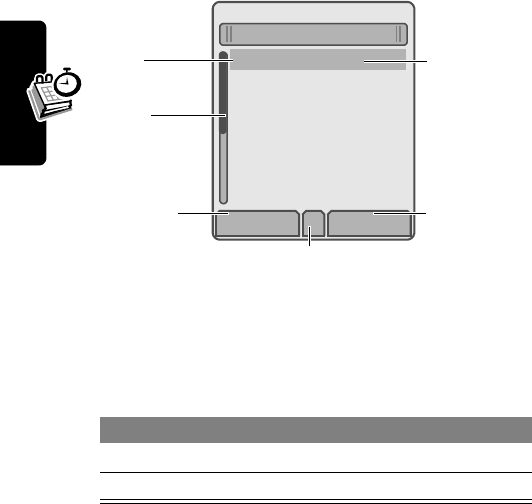
84
PRELIMINARY
Personal Organizer Features
Play a Voice Note
Tip:
You can play a voice note while on a call. It will not be
transmitted to the other party.
Lock and Unlock a Voice Note
Lock a voice note to prevent it from being deleted. You
must unlock a voice note to delete it.
Find the Feature
M
>
Office Tools
>
Voice Notes
Press To
1
S
scroll to the voice note
2
PLAY
(
+
) play the voice note
Find the Feature
M
>
Office Tools
>
Voice Notes
Voice Notes
f10) 2:20pm 4/01/03
9) 4:05pm 3/31/03
8) 4:00pm 3/31/03
7) 11:05am 3/31/03
6) 9:00am 3/31/03
5) 7:15pm 3/30/03
EXIT PLAY
M
Down
scroll
arrow
Locked
voice
note
Return to
previous
screen Press
M
to open the
Voice Notes Menu
Play the
highlighted
voice note
Time/date
recorded
5E
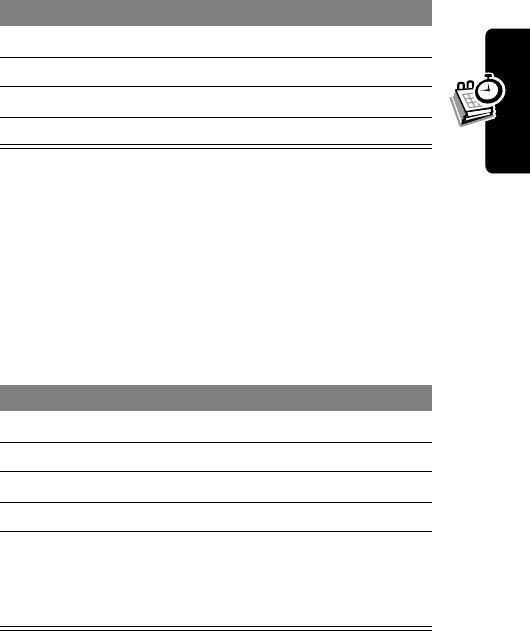
85
PRELIMINARY
Personal Organizer Features
To lock or unlock a voice note during playback, press
M
and select
Lock
or
Unlock
. Playback stops when you lock or
unlock a voice note. Press any number key to resume
playback.
Delete a Voice Note
Press To
1
S
scroll to the voice note
2
M
open the
Voice Notes Menu
3
S
scroll to
Lock
or
Unlock
4
SELECT
(
+
) lock or unlock the voice note
Find the Feature
M
>
Office Tools
>
Voice Notes
Press To
1
S
scroll to the voice note
2
M
open the
Voice Notes Menu
3
S
scroll to
Delete
or
Delete All
4
SELECT
(
+
) select the highlighted option
5
YES
(
+
)
or
NO
(
+
)
confirm the deletion
cancel deletion
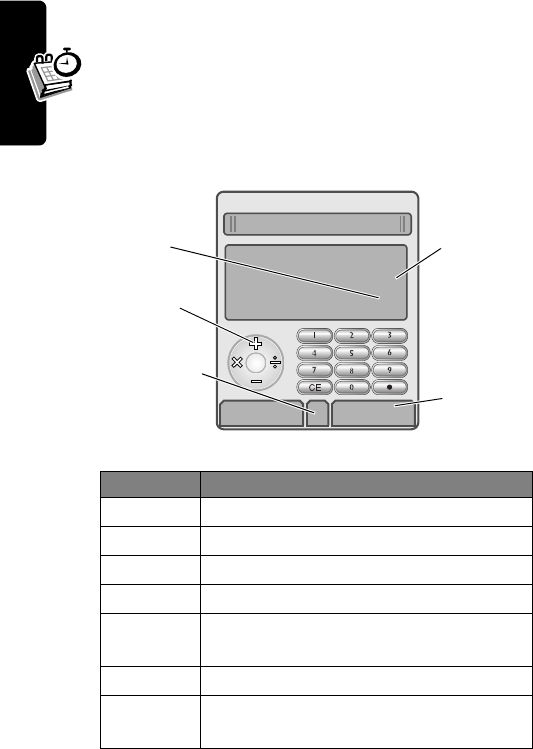
86
PRELIMINARY
Personal Organizer Features
Calculator and Currency
Converter
You can use your phone as a convenient calculator and
currency converter.
Press
M
to open the Calculator Menu functions:
Find the Feature
M
>
Office Tools
>
Calculator
Function Description
MS
Store the displayed number in memory.
MC
Clear memory.
MR
Recall the value stored in memory.
%
Divide the displayed value by 100.
Convert
Currency
Multiply the displayed value by the
Exchange Rate
you stored.
Exit
Exit the calculator.
Exchange
Rate
Store an exchange rate to use with the
Convert Currency
menu option.
M
5E
Selected
function
appears
here
Calculate
the
function
Press
M
to
open the
Calculator Menu
Entered
number
Press
S
to enter
a function
Calculator
0
+
EXIT =
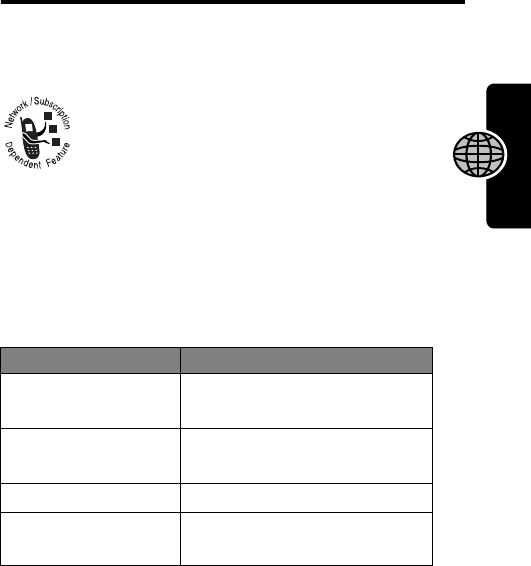
87
PRELIMINARY
News and Entertainment
News and
Entertainment
Mobile Internet
The Web micro-browser lets you access Web
pages and Web-based applications (such as
online banking, shopping, and games) on
your phone. Contact your service provider to
set up access, if necessary.To open the Web micro-
browser:
If you are unable to establish a network connection with
the micro-browser, contact your service provider.
Download Pictures and Sounds
You can download a picture, animation, or sound from a
Web page by selecting its link.
Find the Feature
M
>
WebAccess
>
Browser
Do This To
Press
S
up or
down
scroll through a page
Press
S
left or
right
go back to the previous page
or forward to the next one
Press
M
open the
Browser Menu
Press
M
*
lock your phone’s keypad
while downloading a file
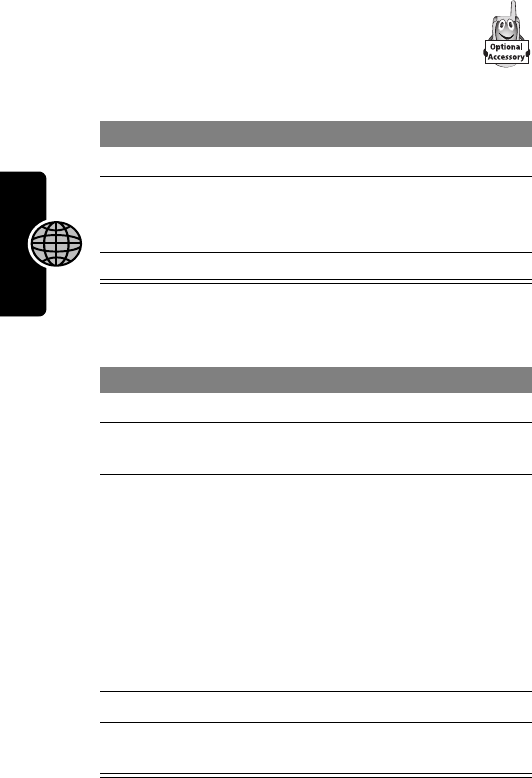
88
PRELIMINARY
News and Entertainment
Note:
To save phone memory, store graphic,
video, and sound files on an SD/MMC card. See
“Using an SD or MMC Card” on page 75.
Storing a Picture or Animation File
Storing a Sound File
Press To
1
STORE
(
+
) view storage options
2
S
scroll to
Store Only
,
Set As Wallpaper
, or
Set as Screen Saver
3
SELECT
(
+
) select the option
Press To
1
STORE
(
+
) view storage options
2
S
scroll to
Store Only
or
Set As Ring Tone
3
SELECT
(
+
) select the option
If you select
Store Only
, the
procedure is complete.
If you select
Set As Ring Tone
,
your phone displays
Set As Which?
, and lists the
events for which you can set
an alert.
4
S
scroll to the event
5
SELECT
(
+
) store the sound and set it as
the event alert
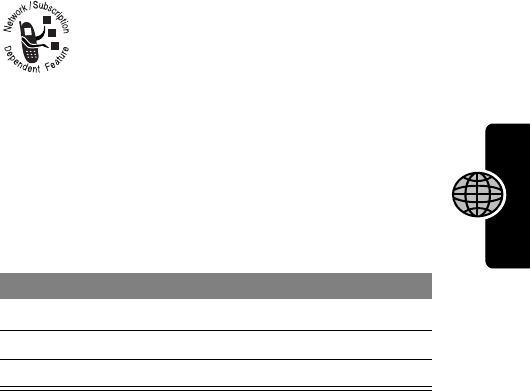
89
PRELIMINARY
News and Entertainment
Java Applications
You can install and run Java applications on
your phone. These applications add new
features and services to your phone.
Download an Application With the
Micro-Browser
Go to the page that contains the Java application you
want, then:
Launch a Java Application
If the application requires an Internet connection, your
phone prompts you to approve the connection.
Camera and Picture Viewer
The camera attachment is not available on all phones.
To capture pictures on your phone, install the camera as
described in “Reinstalling the Camera” on page 17.
Find the Feature
M
>
WebAccess
>
Browser
Press To
1
S
scroll to the application
2
SELECT
(
+
) view the application details
3
DWNLOAD
(
+
) download the application
Find the Feature
M
>
Games & Apps
>the application
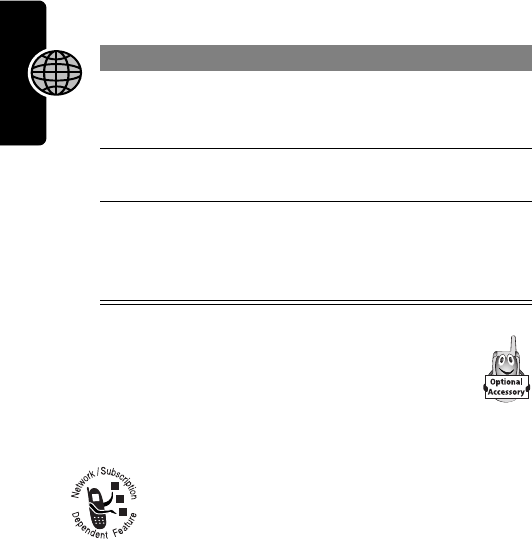
90
PRELIMINARY
News and Entertainment
Capture Pictures
To take a picture, attach the camera/video accessory to
your phone and follow these steps:
The image in the camera’s viewfinder appears on your
phone’s display
Note:
To save phone memory, store graphic,
video, and sound files on an SD/MMC card. See
“Using an SD or MMC Card” on page 75.
Download Pictures
You can download pictures and animations to
your phone and use them as wallpaper or a
screen saver.
Find the Feature
M
>
Media Center
>
Pictures
>
[New Picture]
Do This To
1
Point your phone
at the subject of
the picture
find the picture you want to
take
2
Press
CAPTURE
(
+
)
freeze the picture in your
phone’s display
3
Press
STORE
(
+
)
store the captured picture as
a file, wallpaper, screen
saver, or message
attachment
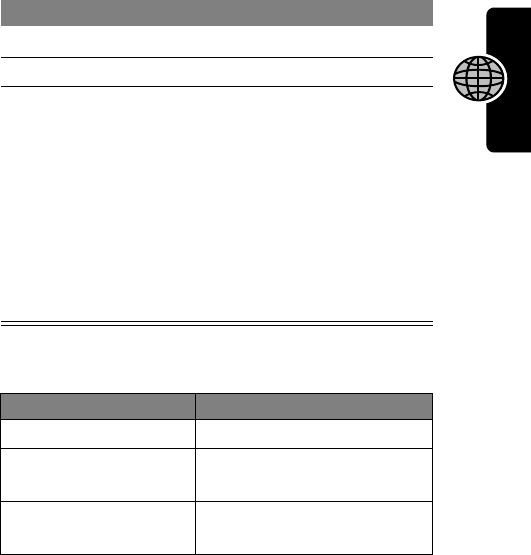
91
PRELIMINARY
News and Entertainment
To download a picture or animation from the
micro-browser, see page 87. To download a picture or
animation from a text message, see page 52.
View Pictures
The
Picture Viewer
menu includes the following options:
Find the Feature
M
>
Media Center
>
Pictures
Press To
1
S
scroll to the picture
2
SELECT
(
+
) view the picture
3
S
left or right
or
DETAILS
(
+
)
or
M
view the previous/next picture
view picture information
open the
Picture Viewer
menu
to perform other procedures
as described in the following
list
Option Description
New Picture
Capture a new picture
New Slideshow
Create a slideshow from a
series of stored pictures
Set as Wallpaper
Set the picture as your
phone’s wallpaper image.
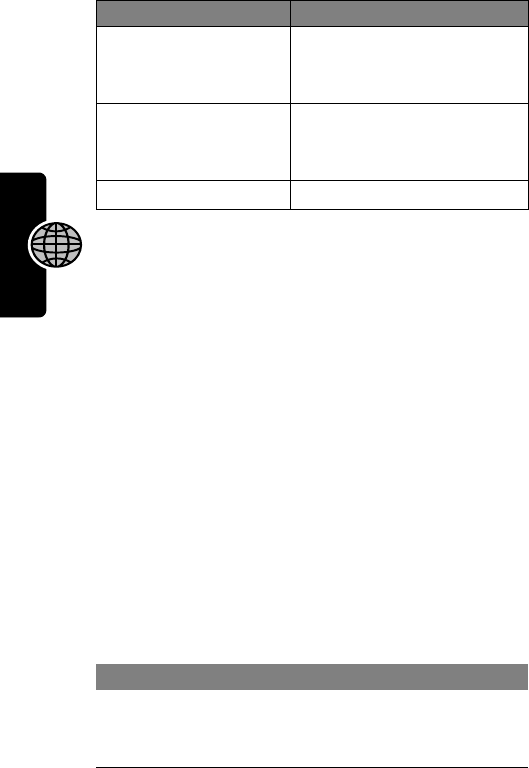
92
PRELIMINARY
News and Entertainment
To adjust your phone’s wallpaper and screen saver
images, see page 63.
Video Recorder and Viewer
The camera attachment is not available on all phones.
To capture videos on your phone, install the camera as
described in “Reinstalling the Camera” on page 17.
Record Videos
To record a video, attach the camera/video accessory to
your phone and follow these steps:
The image in the camera’s viewfinder appears on your
phone’s display
Set as Screen Saver
Set the picture as your
phone’s screen saver
image.
Set as Power-
Up Animation
Set the picture as the image
that appears when you turn
on your phone.
Details
View picture information.
Find the Feature
M
>
Media Center
>
Videos
>
[New Video]
Do This To
1
Point your phone
at the subject of
the video
find the scene you want to
record
Option Description
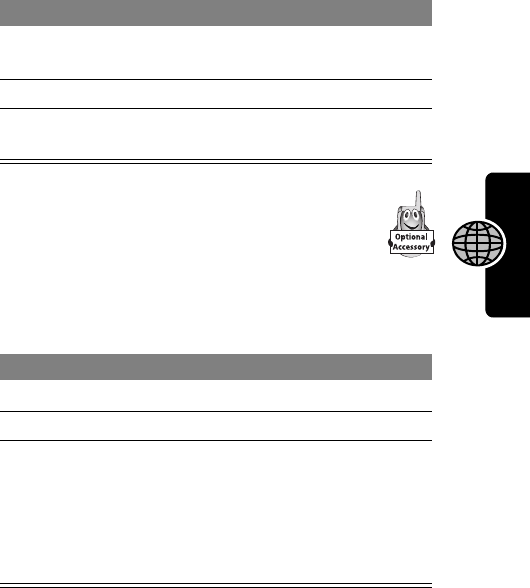
93
PRELIMINARY
News and Entertainment
Note:
To save phone memory, store graphic,
video, and sound files on an SD/MMC card.
See “Using an SD or MMC Card” on page 75.
Watch Videos
Games
You can download Java games to your phone (“Download
an Application With the Micro-Browser” on page 89). If you
get an incoming call, message, alarm, or alert, the game
2
Press
CAPTURE
(
+
)
start recording the scene in
your phone’s display
3
Press
STOP
(
+
) stop recording
4
Press
STORE
(
+
)
store the captured video as a
file or message attachment
Find the Feature
M
>
Media Center
>
Videos
Press To
1
S
scroll to the video
2
PLAY
(
+
) view the video
3
DETAILS
(
+
)
or
M
view video information
open the
Video Player
menu to
perform other procedures as
described in the following list
Do This To
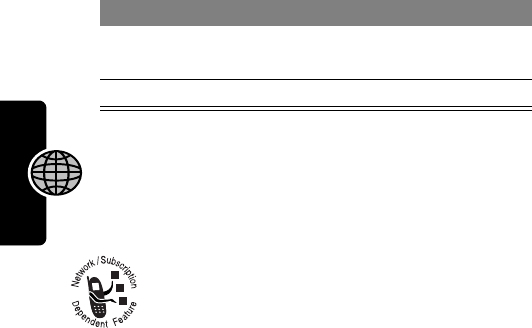
94
PRELIMINARY
News and Entertainment
ends automatically.To open a game that is on your phone:
When the game is over, you can play another session
of the same game or return to the games menu.
SIM Applications
You can access information and applications
stored on your SIM card.
To access the available applications:
Contact your service provider for more details.
Find the Feature
M
>
Games & Apps
Press To
1
S
scroll to the game of your
choice
2
SELECT
(
+
) start the game
Find the Feature
M
>
Services
>
SIM Applications

95
PRELIMINARY
Specific Absorption
Rate Data
The Motorola A830 wireless phone meets the
government’s requirements for exposure to radio waves.
Your wireless phone is a radio transmitter and receiver. It is designed and
manufactured not to exceed limits for exposure to radio frequency (RF)
energy set by the Federal Communications Commission (FCC) of the
U.S. Government and by Health Canada for Canada. These limits are
part of comprehensive guidelines and establish permitted levels of RF
energy for the general population. The guidelines are based on standards
that were developed by independent scientific organizations through
periodic and thorough evaluation of scientific studies. The standards
include a substantial safety margin designed to assure the safety of all
persons, regardless of age or health.
The exposure standard for wireless mobile phones employs a unit of
measurement known as the Specific Absorption Rate, or SAR. The SAR
limit set by the FCC and by Health Canada is 1.6 W/kg.
1
Tests for SAR
are conducted using standard operating positions accepted by the FCC
and by Industry Canada with the phone transmitting at its highest certified
power level in all tested frequency bands. Although the SAR is
determined at the highest certified power level, the actual SAR level of the
phone while operating can be well below the maximum value. This is
because the phone is designed to operate at multiple power levels so as
to use only the power required to reach the network. In general, the closer
you are to a wireless base station, the lower the power output.
Before a phone model is available for sale to the public in the U.S. and
Canada, it must be tested and certified to the FCC and Industry Canada
that it does not exceed the limit established by each government for safe
96
PRELIMINARY
exposure. The tests are performed in positions and locations (e.g., at the
ear and worn on the body) reported to the FCC and available for review
by Industry Canada. The highest SAR value for this model phone when
tested for use at the ear is 0.67 W/kg, and when worn on the body, as
described in this user guide, is 0.14 W/kg. (Body-worn measurements
differ among phone models, depending upon available accessories and
regulatory requirements).
2
While there may be differences between the SAR levels of various
phones and at various positions, they all meet the governmental
requirements for safe exposure.
Additional information on Specific Absorption Rates (SAR) can be found
on the Cellular Telecommunications & Internet Association (CTIA) Web
site:
http://phonefacts.net
or the Canadian Wireless Telecommunications Association (CWTA) Web
site:
http://www.cwta.ca
1. In the United States and Canada, the SAR limit for mobile phones used by
the public is 1.6 watts/kg (W/kg) averaged over one gram of tissue. The
standard incorporates a substantial margin of safety to give additional
protection for the public and to account for any variations in measurements.
2. The SAR information includes the Motorola testing protocol, assessment
procedure, and measurement uncertainty range for this product.
ITC02-155

97
PRELIMINARY
Warranty
MOTOROLA LIMITED WARRANTY FOR THE UNITED
STATES AND CANADA
What Does this Warranty Cover?
Subject to the exclusions contained below, Motorola, Inc.
warrants its telephones, pagers, and consumer and professional
two-way radios (excluding commercial, government or industrial
radios) that operate via Family Radio Service or General Mobile
Radio Service, Motorola-branded or certified accessories sold for
use with these Products (“Accessories”) and Motorola software
contained on CD-ROMs or other tangible media and sold for use
with these Products (“Software”) to be free from defects in
materials and workmanship under normal consumer usage for
the period(s) outlined below. This limited warranty is a
consumer's exclusive remedy, and applies as follows to new
Motorola Products, Accessories and Software purchased by
consumers in the United States or Canada, which are
accompanied by this written warranty:
Products and Accessories
Products Covered Length of Coverage
Products and Accessories
as
defined above, unless otherwise
provided for below.
One (1) year
from the date of purchase
by the first consumer purchaser of the
product unless otherwise provided for
below.

98
PRELIMINARY
Exclusions
Normal Wear and Tear.
Periodic maintenance, repair and
replacement of parts due to normal wear and tear are excluded
from coverage.
Batteries.
Only batteries whose fully charged capacity falls
below 80% of their rated capacity and batteries that leak are
covered by this limited warranty.
Abuse & Misuse.
Defects or damage that result from:
(a) improper operation, storage, misuse or abuse, accident or
neglect, such as physical damage (cracks, scratches, etc.) to the
surface of the product resulting from misuse; (b) contact with
Decorative Accessories
and Cases
. Decorative
covers, bezels,
PhoneWrap™ covers and
cases.
Limited lifetime warranty
for
the lifetime of ownership by the
first consumer purchaser of the
product.
Monaural Headsets.
Ear
buds and boom headsets
that transmit mono sound
through a wired connection.
Limited lifetime warranty
for
the lifetime of ownership by the
first consumer purchaser of the
product.
Consumer and
Professional Two-Way
Radio Accessories.
Ninety (90) days
from the date
of purchase by the first
consumer purchaser of the
product.
Products and
Accessories that are
Repaired or Replaced.
The balance of the original
warranty or for ninety (90)
days
from the date returned to
the consumer, whichever is
longer.
Products Covered Length of Coverage

99
PRELIMINARY
liquid, water, rain, extreme humidity or heavy perspiration, sand,
dirt or the like, extreme heat, or food; (c) use of the Products or
Accessories for commercial purposes or subjecting the Product
or Accessory to abnormal usage or conditions; or (d) other acts
which are not the fault of Motorola, are excluded from coverage.
Use of Non-Motorola Products and Accessories.
Defects or
damage that result from the use of Non-Motorola branded or
certified Products, Accessories, Software or other peripheral
equipment are excluded from coverage.
Unauthorized Service or Modification.
Defects or damages
resulting from service, testing, adjustment, installation,
maintenance, alteration, or modification in any way by someone
other than Motorola, or its authorized service centers, are
excluded from coverage.
Altered Products.
Products or Accessories with (a) serial
numbers or date tags that have been removed, altered or
obliterated; (b) broken seals or that show evidence of tampering;
(c) mismatched board serial numbers; or (d) nonconforming or
non-Motorola housings, or parts, are excluded form coverage.
Communication Services.
Defects, damages, or the failure of
Products, Accessories or Software due to any communication
service or signal you may subscribe to or use with the Products
Accessories or Software is excluded from coverage.
Software
Products Covered Length of Coverage
Software.
Applies only to physical defects
in the media that embodies the copy of the
software (e.g. CD-ROM, or floppy disk).
Ninety (90) days
from the
date of purchase.
100
PRELIMINARY
Exclusions
Software Embodied in Physical Media.
No warranty is made
that the software will meet your requirements or will work in
combination with any hardware or software applications provided
by third parties, that the operation of the software products will be
uninterrupted or error free, or that all defects in the software
products will be corrected.
Software NOT Embodied in Physical Media.
Software that is
not embodied in physical media (e.g. software that is
downloaded from the internet), is provided “as is” and without
warranty.
Who is Covered?
This warranty extends only to the first consumer purchaser, and
is not transferable.
What Will Motorola Do?
Motorola, at its option, will at no charge repair, replace or refund
the purchase price of any Products, Accessories or Software that
does not conform to this warranty. We may use functionally
equivalent reconditioned/refurbished/pre-owned or new
Products, Accessories or parts. No data, software or applications
added to your Product, Accessory or Software, including but not
limited to personal contacts, games and ringer tones, will be
reinstalled. To avoid losing such data, software and applications
please create a back up prior to requesting service.

101
PRELIMINARY
How to Obtain Warranty Service or Other
Information
You will receive instructions on how to ship the Products,
Accessories or Software, at your expense, to a Motorola
Authorized Repair Center. To obtain service, you must include:
(a) a copy of your receipt, bill of sale or other comparable proof of
purchase; (b) a written description of the problem; (c) the name
of your service provider, if applicable; (d) the name and location
of the installation facility (if applicable) and, most importantly;
(e) your address and telephone number.
What Other Limitations Are There?
ANY IMPLIED WARRANTIES, INCLUDING WITHOUT
LIMITATION THE IMPLIED WARRANTIES OF
MERCHANTABILITY AND FITNESS FOR A PARTICULAR
PURPOSE, SHALL BE LIMITED TO THE DURATION OF THIS
LIMITED WARRANTY, OTHERWISE THE REPAIR,
REPLACEMENT, OR REFUND AS PROVIDED UNDER THIS
EXPRESS LIMITED WARRANTY IS THE EXCLUSIVE
REMEDY OF THE CONSUMER, AND IS PROVIDED IN LIEU
OF ALL OTHER WARRANTIES, EXPRESS OR IMPLIED. IN NO
EVENT SHALL MOTOROLA BE LIABLE, WHETHER IN
CONTRACT OR TORT (INCLUDING NEGLIGENCE) FOR
USA
Phones 1-800-331-6456
Two-Way Radios 1-800-353-2729
Pagers 1-800-548-9954
Canada
All Products 1-800-461-4575
TTY
TTY 1-888-390-6456
For
Accessories
and
Software
, please call the telephone number desig-
nated above for the product with which they are used.
102
PRELIMINARY
DAMAGES IN EXCESS OF THE PURCHASE PRICE OF THE
PRODUCT, ACCESSORY OR SOFTWARE, OR FOR ANY
INDIRECT, INCIDENTAL, SPECIAL OR CONSEQUENTIAL
DAMAGES OF ANY KIND, OR LOSS OF REVENUE OR
PROFITS, LOSS OF BUSINESS, LOSS OF INFORMATION OR
DATA, SOFTWARE OR APPLICATIONS OR OTHER
FINANCIAL LOSS ARISING OUT OF OR IN CONNECTION
WITH THE ABILITY OR INABILITY TO USE THE PRODUCTS,
ACCESSORIES OR SOFTWARE TO THE FULL EXTENT
THESE DAMAGES MAY BE DISCLAIMED BY LAW.
Some states and jurisdictions do not allow the limitation or
exclusion of incidental or consequential damages, or
limitation on the length of an implied warranty, so the above
limitations or exclusions may not apply to you. This
warranty gives you specific legal rights, and you may also
have other rights that vary from state to state or from one
jurisdiction to another.
Laws in the United States and other countries preserve for
Motorola certain exclusive rights for copyrighted Motorola
software such as the exclusive rights to reproduce and distribute
copies of the Motorola software. Motorola software may only be
copied into, used in, and redistributed with, the Products
associated with such Motorola software. No other use, including
without limitation disassembly of such Motorola software or
exercise of the exclusive rights reserved for Motorola, is
permitted.
ITC02-162